
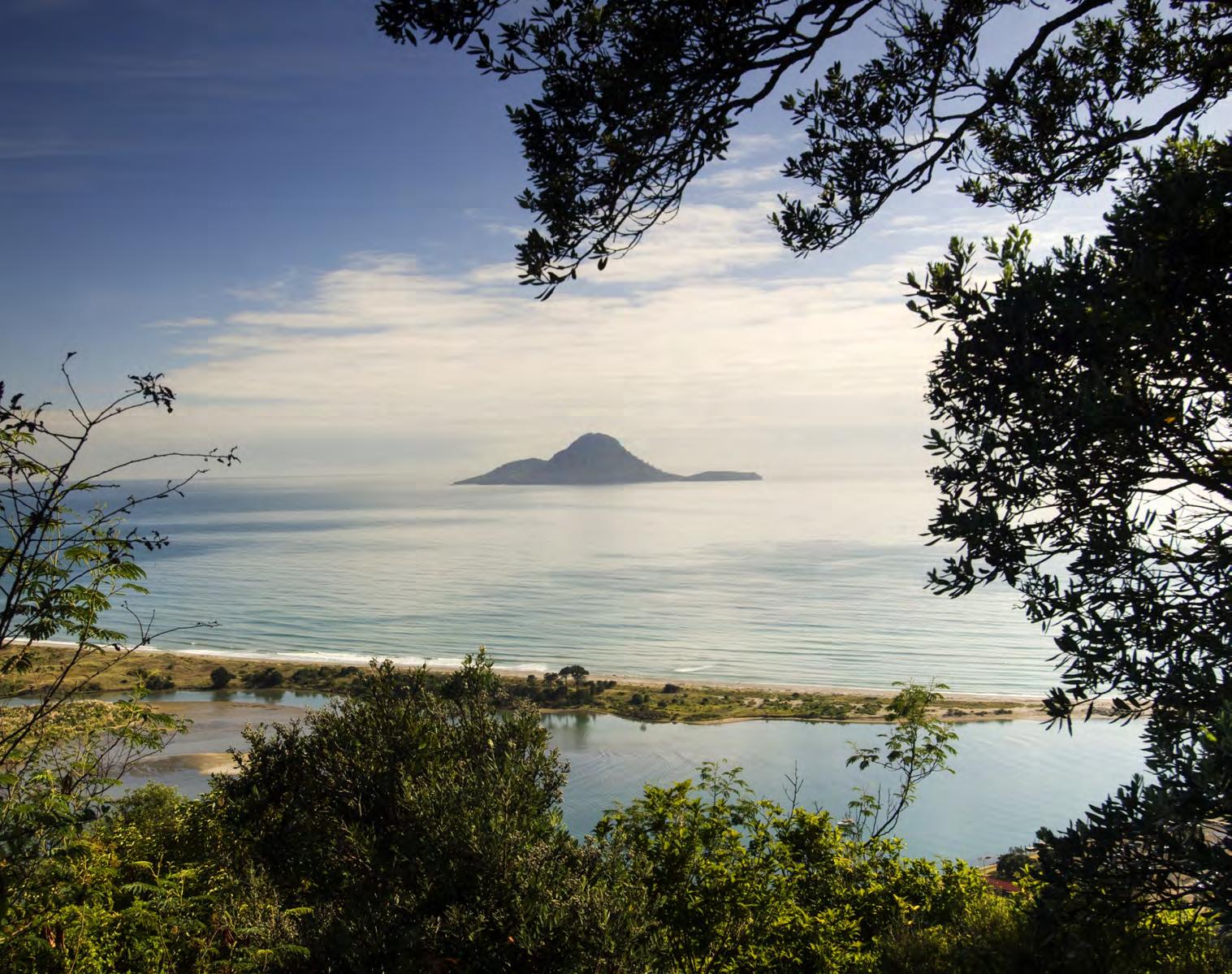















































It has been three in a row for Tauranga based software company LawVu with the company recently completing a $17 million capital fund raising exercise, its third in less than two years.
By RICHARD RENNIE
The successful exercise was managed by New York-based global equity company Insight Partners, supported by Australian company AirTree Ventures. The company had initially raised $2.5 million in convertible notes, then $17 million almost a year ago.
LawVu specialises in producing legal software for in-house corporate legal teams, and was the brainchild of local businessmen Tim Boyne and Sam Kidd.
Boyne had extensive experience working with a local law firm and had regularly become frustrated with the slow and difficult processes of tracking legal team performance and workloads.
Company growing worldwide
The company has grown to now be in 30 countries including Australia, the US and the UK, participating in what is believed to be a $50 billion legal tech market.
The company was also named Bay of Plenty Business of the Year for 2021.
Co-founder Tim Boyne says the company has witnessed the uptake of their software accelerate in the past year.
“The additional support from our existing investors shows tremendous



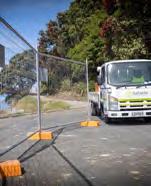
confidence in our traction, our team, and our vision.
“It enables us to accelerate our international expansion and meet the ever-growing needs of customers in each region,” he says.
The company’s software has been a disruptor in a market that had changed little over the years.
A survey revealed 15 percent of lawyers were tracking contractual obligations on Post-it notes, with white boards often the main means for large legal teams to keep track of their jobs and deadlines.
Clients taken on board include Australian giant telco Telstra, the company’s breakthrough client with the largest in-house legal counsel in the Southern Hemisphere.
Other clients here in New Zealand include Zespri, Fonterra, LIC, Sky and Harcourts.
One city council has reportedly saved more than 40 percent on out-
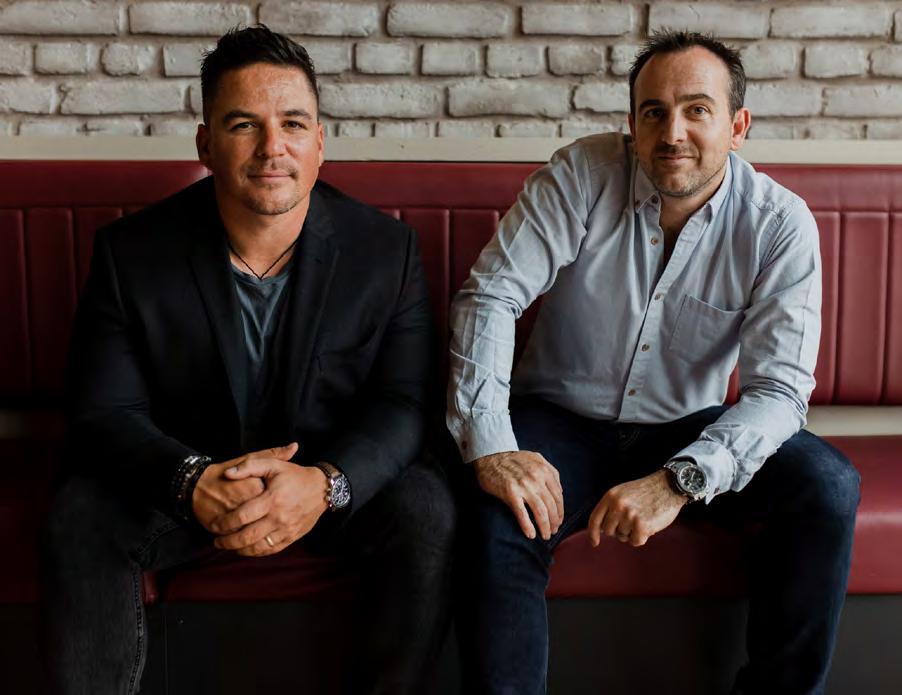
side legal expenditure through better management of the team it has, by using LawVu.
The additional support from our existing investors shows tremendous confidence in our traction, our team, and our vision. It enables us to accelerate our international expansion and meet the ever-growing needs of customers in each region.”


With 30 staff based in Tauranga, the company now has 70 staff spread around the globe with Australia among the firm’s top markets and the United States gaining strength.
James Cameron, a partner in AirTree Ventures said with an inside view on the business’s performance it
was an easy decision to double down on investment.
The LawVu software consists of a unified suite of tools frequently used by legal teams, including contract templates, time management systems and e-billing processes.
The emphasis upon a user-friendly interface has seen it gain strong support within legal teams using it, say the founders.











www.bopbusinessnews.co.nz
CONTACT INFORMATION
PUBLISHER
Alan Neben, Ph: 021 733 5366
Email: alan@bopbusinessnews.co.nz
EDITOR
David Porter, Mob: 021 884 858
Email: david@bopbusinessnews.co.nz
PRODUCTION – Copy/Proofs/Graphic Design Times Media – Clare McGillivray
Email: clare@times.co.nz
ADVERTISING INQUIRIES
BUSINESS DIRECTOR
Pete Wales, Mob: 022 495 9248
Email: pete@bopbusinessnews.co.nz
ELECTRONIC FORWARDING
EDITORIAL: News releases/Photos/Letters: david@bopbusinessnews.co.nz
GENERAL INQUIRIES: info@bopbusinessnews.co.nz
Bay of Plenty Business News has a circulation of 8000, distributed throughout Bay of Plenty between Waihi and Opotiki including Rotorua and Taupo, and to a subscription base.
www.bopbusinessnews.co.nz
Bay of Plenty Business Publications
309/424 Maunganui Rd, Mt Maunganui, 3116
Bay of Plenty Business Publications specialises in business publishing, advertising, design and print media services.
I am reluctant to revisit past editorial subjects – especially as there are always plenty of new goings-on that are of interest to our local business readers. However, our annual Anzac Day remembrance day has coincided, sadly, with the continuing contemporary devastation of the Ukraine by Russia.
Anzac Day remains for New Zealanders and Australians a solemn and tragic memory of, not only those who served at Gallipoli, but of all who fought and lost their lives in overseas wars.
In New Zealand, it was thought in 2020 there were about 600 Anzac soldiers still living nationwide. This is now thought to have dwindled to about 400, but the exact numbers are not known.
What is known is that, obviously, most of those who survived the first and other world wars, are by now aged and in many cases very fragile. Nonetheless memories of their
service lingers and they are held in great reverence.
As a long-time watcher of The History Channel and other similar documentary productions I am always astonished and horrified at the cruel waste inflicted upon soldiers, in many cases by those comfortably far from the firing lines.
Watching the ongoing wreckage of the Ukraine, which is apparently being punished by Russia for daring to assert itself as an independent and Western-tending nation, is a terrible and dispiriting experience. To have it happen during Anzac Day remembrances seems just too
sad and ironic. As we have noted in the past, this by no means a solely European war. As all too many New Zealand businesses can attest, this conflagration is having an effect on the supplies of all manner of goods to places as far flung from Europe as New Zealand and Australia. And this at a time when supply chains were already badly hurt by the knock-on effects of Covid-19.
In our own business of printing and publishing we are finding that the costs of basic materials are soaring.
At the time of writing, it was impossible to predict the

outcome of the Ukraine invasion. However, there seems general agreement that the invasion was ill-judged and will not improve Russian President Vladimir Putin’s status in the world. There also seems to be some hardening of anti-Russian views in much of the western-aligned world. Putin clearly was aiming for the opposite impact and is likely to be disappointed in the outcome. There are unlikely to be any victors in this war.

In case you missed last month’s edition Scan to subscribe


It’s time to throw digital tools, not people, at our productivity problem – p8

The proposed development of Tauranga’s civic precinct – Te Manawataki o Te Papa – is one strand of a much wider strategy to revitalise the city centre.
By ANNE TOLLEY, Tauranga Commission Chair
The strategy is built around planned, complementary developments in eight identified CBD precincts at the northern end of the Te Papa peninsula, all of which are within easy walking distance.
Some of the developments under consideration are Council-led, some are government or education institute-led, while others are private investments or community organisation-led.
The civic and hospitality precinct – the area between Cameron Road and the waterfront, bounded by Harington and Spring Streets – sits at the heart of the overlapping precinct areas.
Immediately to the north is the justice precinct, site of planned court building developments; to the south are the education (University of Waikato and Toi Ohomai) and retail and commercial precincts; to the west is the sports and events (Tauranga and Wharepai Domains) precinct; and to the east is the waterfront/Dive Crescent precinct.
Further to the north is the cultural and historic precinct (Mission Street and Cliff Road); while further to the south and south-west is the mixed-use precinct where more intensive residential and commercial development is anticipated.
Related strategy elements include a housing intensification area to the south of the CBD; the proposed Memorial Pathway linking Memorial Park to the city centre, the proposed Memorial Park destination park and the Cameron Road multi-modal corridor.
1
2
3
4
The civic precinct is located in the heart of the Tauranga CBD, in the centre of a number of other significant precincts.
5 Civic and Hospitality Precinct
6 Retail and Commercial Precinct
7 Education Precinct
8 Mixed Use Precinct
1Cultural and Historic Precinct
9 Housing Intensi cation Area
2Justice Precinct
3Waterfront / Dive Crescent Precinct
10 Proposed Memorial Pathway 11 Cameron Road Multi Modal Corridor
4Sports and Events Precinct
5Civic and Hospitality Precinct
12 Memorial Park - Destination Park
6Retail and Commercial Precinct
7Education Precinct
8Mixed Use Precinct
9Housing Intensication Area
10Proposed Memorial Pathway
11Cameron Road Multi Modal Corridor
12 Memorial Park - Destination Park
The Civic Precinct area could see the most intensive development in the short-term, both through the masterplan refresh projects currently being consulted upon through Tauranga City Council’s proposed long-term plan amendment, and a number of private developments planned in the immediate area.


Construction of the library and community hub project on the corner of Wharf and Willow Streets is planned to commence later this year and the Commission will be making decisions on the other precinct projects – a museum and exhibition/events space, a Civic Whare (council and community meeting space) and an upgraded waterfront area between Hamilton and Wharf Streets, linking to the civic precinct through Masonic Park – over the next two months.
Some aspects of the city centre strategy are still in the early stages of development, but taken as a whole, there is more than enough here to give us confidence that the CBD has an exciting and vibrant future in store.” – Anne Tolley
planned on Devonport Road (including the leased Council administration building to be constructed at 90 Devonport Road, starting later this year) will add further impetus to the city centre’s long-awaited recovery.
Some aspects of the city centre strategy are still in the early stages of development, but taken as a whole, there is more than enough here to give us confidence that the CBD has an exciting and vibrant future in store.
Significant developments have already been completed in the education precinct, highlighted by the magnificent University of Waikato campus building.
Further educational facilities are likely and additional student accommodation developments are also expected.
The sports and events precinct also has considerable potential and could be the home of a future stadium development now in the early stages of feasibility investigation.
Highlighting development in the retail and commercial precinct is the major Farmers’ retail and residential complex, which is already underpinning a resurgence in this part of the CBD.
Commercial building developments underway or
I can’t wait to see that future take shape and I look forward to a time when the cultural and commercial heart of our city is once again beating strongly and we have a city centre we can all enjoy and be proud of –a place where people will want to live, work, learn and play.
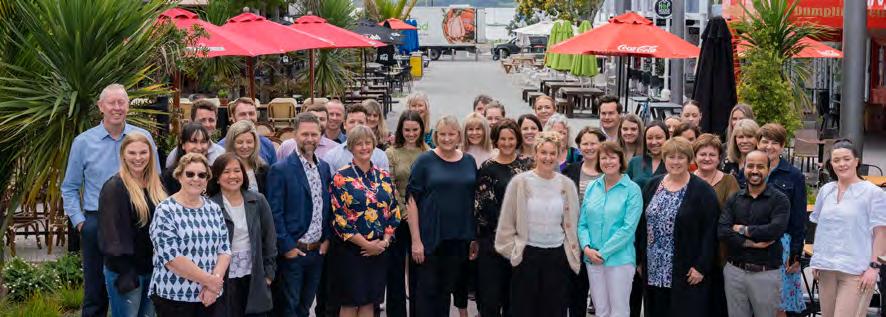

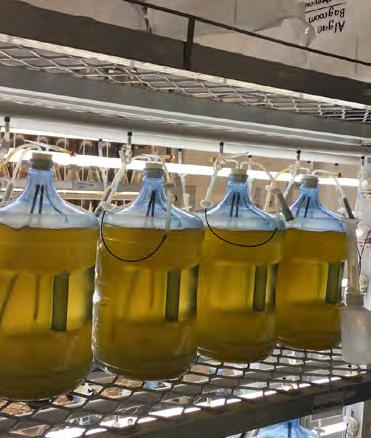
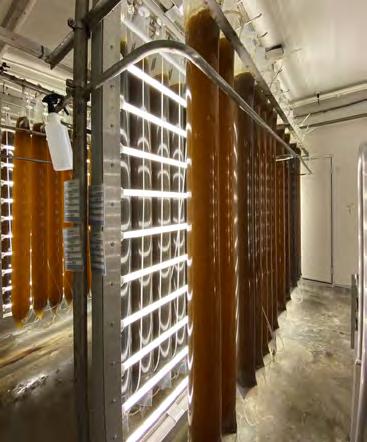

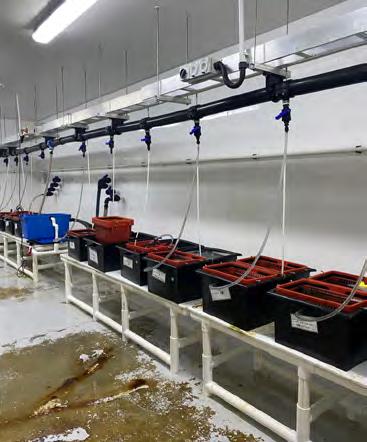
By DAVID PORTER
The Eastern Bay of Plenty has been making steady economic progress in recent years with GDP up over 10 percent in Whakatane in the last year, the new Whakatane marina now formally started, as well as a new harbour underway in Opotiki.
As noted by Karl Gradon – who recently ended a lengthy term as general manager for strategy at the Eastern Bay of Plenty’s Toi EDA to take up the post of chief executive at Māori dairy company Miraka Ltd – Whakatane and Opotiki are the only places with greenfield waters-edge portlike facilities underway in New Zealand.
And now, says Gradon, the region has embarked on funding and development for the Te Kaha mussel spat project, which he described as massive.
“It’s the biggest employment and economic opportunity in the town since the large-scale kiwifruit and manuka plantations have been developed,” said Gradon.
Haydn Dr Read, who has a PhD in infrastructure and has been advising the iwi on the mussel spat project, told Bay of Plenty Business News that the plan was well underway and on course.
Partnering with community
The government is partnering with the community to help develop a hatchery in Te Moana-aToi Bay of Plenty, near Te Kaha.
Eastern Bay of Plenty iwi Te Whānau-āApanui will get money from the new Regional Strategic Partnership Fund (RSPF) so it can develop a hatchery and research hub in Kaiaio, near Te Kaha.
According to Dr Read, the project has been successful in getting $6 million from government. Dr Read said the whanau had also been able to secure some funding from its own resources and now had around $8 million.
“That’s a really strong step in our $40 to $50 million build cost,” he said.
There is now a call for investors with an Information Memorandum (IM) to several interested parties who support the project, he said.
Accelerating the aquaculture industry has been identified as one of the priorities for economic growth in the Bay of Plenty, according to a recent newspaper report and comments from stakeholders and others involved with the project.
The government said recently the investment would deliver on a manifesto commitment to keep supporting regional economic development once the Provincial Growth Fund closed to applications.
This is the second major investment from the new fund, after the Government’s equity stake
Dr Read noted the importance of the mussel processing factory created by the Whakatōhea company as well as the $100 million in Opotiki harbour development.
Whakatōhea is an iwi centred around Ōpōtiki, which had the aspiration to develop its aquaculture farm off the coastline of Ōpōtiki some 20 years ago. It was no easy feat – the consent process took over 10 years of legislative change and resource consent approval, followed by a further five years of research and feasibility trials.
Today – with iwi support, government con-
Spat are very young shellfish, and the raw material of mussel farms. Mussel spat develop from a floating larval stage. The larvae attach themselves to seaweed or ropes and develop into miniature shellfish 0.3mm long – about the width of a needle tip. They move from site to site until they are 0.6mm in length, when they attach themselves permanently to a settlement site. Green-lipped mussel spat are oval with brown zigzag markings on the shell.”
– Te Ara, The Encyclopedia of New Zealand
in the Geo40 Lithium Recovery project near Taupō.
Economic and regional development minister Stuart Nash said the investment would have a significant impact locally and nationally.
“Having a reliable source of quality hatchery spat is an important step in helping the nation’s aquaculture industry be more resilient, improving its supply chain and securing its long-term sustainability,” he said.
Gage has a wealth of experience in the marine environment. He served as a member of the Ministerial Advisory Committee for Oceans Policy and was prominent during the allocation discussions. He represented the Treaty of Waitangi Fisheries Commission at the Convention on Biological Diversity in Argentina in 1996.
Basically land-based project
“It’s basically land based, with a whole lot of ponds and tanks,” he said.
Working with mussel brood stock, male and female are brought together and fertilised to form a tiny mussel, and then fed algae in large tanks, before being settled on ropes and taken into the harbour to grow to full size.

“We’re going to grow enough mussel spat for the mature equivalent weight of 30,000 tonnes of harvested mussels,” said Dr Read. “That’s the equivalent to nearly one-third of the national production.” He noted that the Te Whānau-ā-Apanui had a team of research scientists working with at Cawthorne (Nelson). He also noted, a number of senior students at Massey and Waikato universities who were also interested in becoming involved in the project.
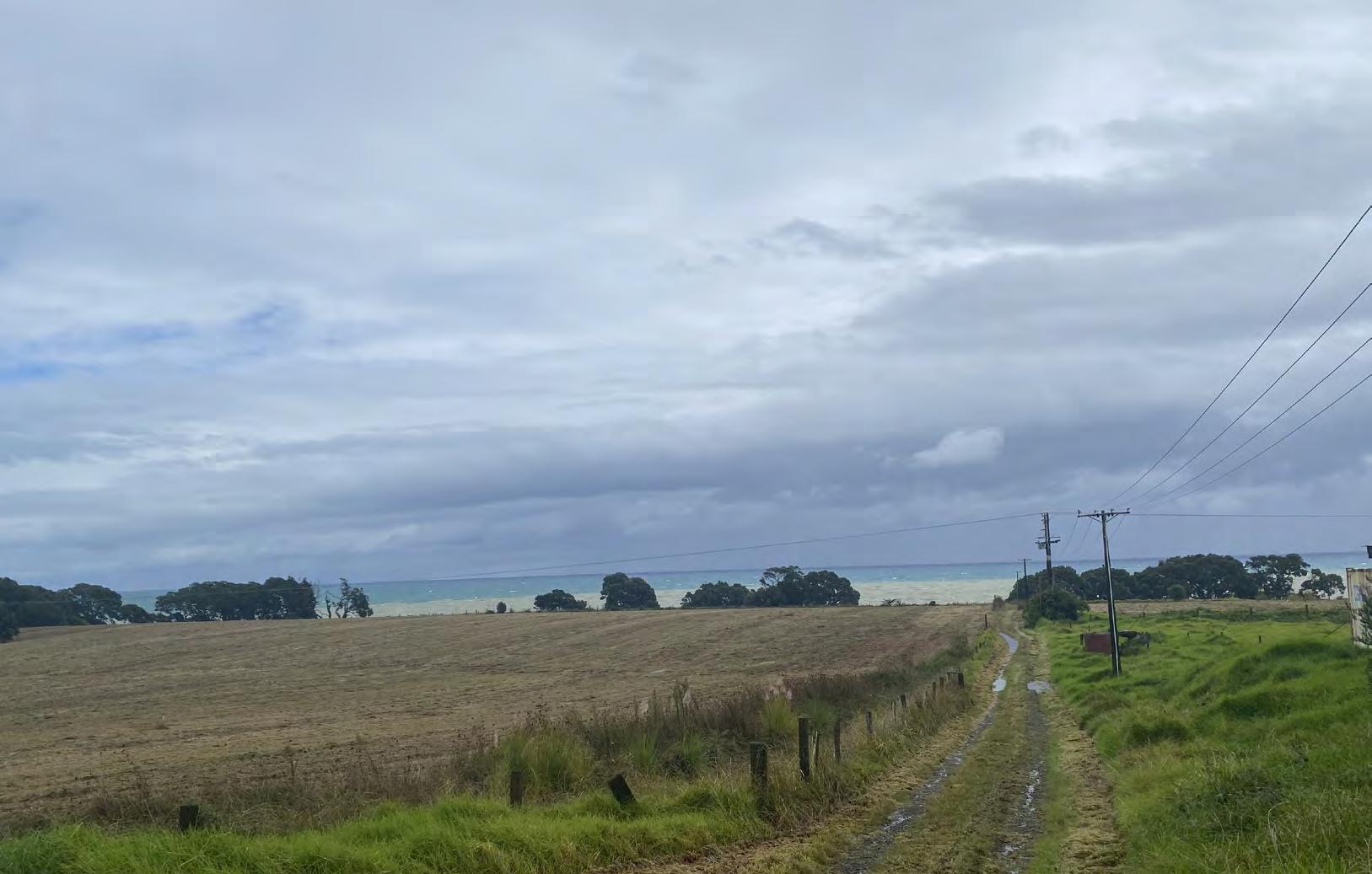
tribution, and significant shareholder investment – Te Whakatōhea Mussel Farm is a reality, currently lying just over 8.5 km off the coastline of Ōpōtiki. The farm expands across over 3800 ha.
Dr Read, who works for Rikirangi Gage, the chief executive officer for Te Rūnanga o Te Whānau, noted that both local iwi are also negotiating 5000 ha of seawater space as part of their settlement with the Crown, meaning both had space for future mussel farming development.
The team hoped to go to the first of the consent process in readiness or earthworks to commence in the coming spring. The team has targeted a completion date of late 2023 /early 2024.
“When complete, we plan to have enough mussel spat put in the water to create opportunities for some 1000 people in suitable regions around the country.
“The sea space around New Zealand is in the order of 2 times larger than the land space farmed in New Zealand and our Exclusive Economic Zone is the fourth-biggest in the world,” said Dr Read.
“We’re growing an aquaculture industry which is going to set the tone for the next generation of economic growth in the region and nationally,” he said.
“In 30, 40, 50 years it could be bigger than dairy and forestry. We’ve got things in hand but we’re not stopping.”
Late January marked a great milestone for Enterprise Angels, which invested in its 100th start-up. The journey began in 2008 and since then EA’s members, funds and the wholesale investor community have collectively invested more than $58 million dollars.
Based in Tauranga, Enterprise Angels has become one of New Zealand’s largest, most active, and best resourced Angel networks in New Zealand.
And while the financial inputs are extremely important, the other less visible inputs are equally important –active angel members have supported these businesses in numerous ways through utilising their experience, skills, and connections.
Most of the portfolio companies are software (39 percent), hardware (26 percent), or agtech (23 percent), with the majority being based in Auckland (41 percent), Bay of Plenty (18percent) and Wellington (18 percent).
A good number of the startups have a strong international presence with global corporates as clients – Fuel50 and Parrot Analytics to name a couple.
In terms of stage of companies at the time of investment, the majority is at the start-up stage (61 percent), when companies have early revenues, with 23 percent of companies being pre-revenue and 16 percent at an early expansion stage.
In regards to the amount of capital invested, almost 50 percent is at the early expansion stage, meaning Enterprise Angels tends to double down as companies prove their value proposition and start to see product market fit – the risk at this stage is considerably reduced.
Enterprise Angels has invested in a total of 157 follow-on investment rounds. Sometimes these rounds are exclusively for existing investors but often the amount of capital the companies are seeking is greater than existing investors can support so there can be an opportunity for new investors to get onboard.
Founding of Enterprise Angels
Enterprise Angels was founded by Bill Murphy who launched the organisation in 2008, then named Western Bay of Plenty Investors’ Forum (a bit of a mouthful). In the early years there were just a dozen or so members and only a couple of investments were made each year. Now there are 200 members and a further 148 wholesale investors and over the last two years the group has invested about $13 million in 18 new startups
and 40 follow-on rounds. “I originally started Enterprise Angels to provide an avenue for start-ups to successfully raise capital and get more than just money,” said Murphy.
“Back in the day, founders came to me due to my involvement with the local EDA. I realised we had to get a better system in place; the only early-stage capital at the time was contacting the local rich guy… We’ve certainly come a long way.
“The growth path of a start-up can be affected dramatically by having successful business angels as investors. They connect founders to potential clients, other investors, future staff and more. They help guide founders in areas that they have experience in either informally or as a director, and sometimes they just provide moral support.”
In 2019 Bill stepped down to lead the Purpose Capital Impact Fund, and Nina Le Lievre became the country’s first female angel network Chief Executive. Le Lievre had been working alongside Bill at Enterprise Angels for six years prior to this.
Murphy continues to support Enterprise Angels in a part time capacity as Executive Chair.
Enterprise Angels has a unique angel group model whereby they have seven professional staff with capital raising and administration expertise who work closely with their 200
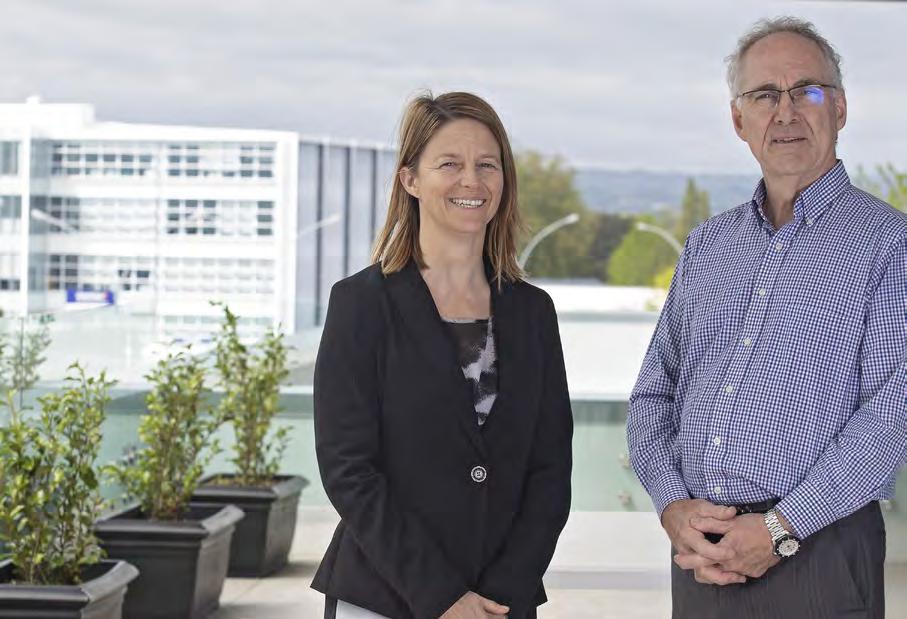
Currently, Enterprise Angels manages three angel funds, EA Fund 1, EA Fund 2, and EA Fund 3. Both EA Fund 1 and 2 are fully invested
Last year we created an Exit Committee, comprised of experienced entrepreneurs and angels, to specifically focus on exponential growth paths of our more mature portfolio companies.” – Nina Le Lievre
members to source deals, undertake due diligence and work with companies post investment.
Enterprise Angels combines the strengths of its Angel network (members’ breadth and depth of experience and expertise) with the strengths of a fund (coordinating and streamlining the investment decision process) to attract better deals and deliver a better result for investee companies and investors.

and EA Fund 3 is likely to be fully invested at the end of the first quarter of 2022.
The fund portfolios include some very well known, high growth NZ companies such as Fuel50, Parrot Analytics, Rockit Global, UBCO, Mint Innovation and Fileinvite. Enterprise Angels will continue to provide this important funding option for entrepreneurs and investors by launching a new fund in mid 2022.
Angel investing is risky. As with all risk, there are ways to mitigate it. The best way for an angel investor to mitigate this risk is to 1) build a portfolio of early-stage investments, i.e., diversify; and 2) invest in what you know and understand. Enterprise Angels does this by leveraging the broad experience of members and partners to increase the chances of portfolio companies succeeding. Collaboration and learning are instrumental in the successes. But even with the best due diligence or support – start-ups will fail. It’s a fact. It’s not easy to grow an international company. Many ‘overnight’ successes have 10-20 years of hard work under their belts. EA has seen 17 of its companies fail for various reasons – timing, capital, product, resourcing. That’s never easy for investors, but more importantly it’s not easy for founders. It’s important to learn from failures and support those founders to grow as a result. EA said it knows that second time founders are statistically more likely to succeed and that they learn more from their failures than from their successes.
On the positive side, successful results make up for the failures. In fact, statistically some 85 percent of returns are reported to come from about 10 percent of angel investments. Enterprise Angels, has seen some very profitable returns from its companies: Greenbutton, SwipedOn, Volpara, Engender, Merlot Aero and more recently Moxion.
The IRRs range from 24 percent with Merlot Aero to 194 percent with SwipedOn.
“As our portfolio companies mature, we look forward to seeing what successes they will achieve. Last year we created an Exit Committee, comprised of experienced entrepreneurs and angels to specifically focus on exponential growth paths of our more mature portfolio companies.”
Le Lievre is excited by what the future holds for Enterprise Angels in terms of the new start-ups she is seeing that are solving some gnarly global problems and the exciting growth of existing portfolio companies, as well as the strong sense of community that continues to grow within the Enterprise Angels Membership.
To find out more about Enterprise Angels visit www.enterpriseangels. co.nz

We went into the pandemic with a relatively healthy economy. An economy we had achieved through the brute force of hardworking people.
iwi small business own-
Kers are truly some of the most resilient and passionate people I’ve ever met. It takes a lot of courage to take the step to go out on your own, become your own boss and build something from the ground up.
In the face of countless challenges faced by the pandemic, small business owners have pivoted, adapted and coped.
But while our small business community has done extraordinarily well during the past two years of Covid restrictions, the reality is, our focus needs to shift from surviving today to setting up building blocks for the future.
When the pandemic first reached our shores, this was the kick many needed to begin investing in digitalisation.
Those who did saw the fruits of their labour –

> BY CRAIG HUDSON
Craig Hudson is Xero’s managing director for New Zealand and the Pacific Islands.
increased e-commerce capabilities provided access to new customer lines and the ability to pivot to remote work kept many operations active.
But for the most part, we threw people and long hours at the problem, rather than working more efficiently. With 2022 well underway, many small businesses are feeling the sheer exhaustion of facing two years in a pandemic.
The simple fact is, a lot of SMEs weren’t adequately prepared to handle how long the wrath of the global pandemic has lasted.
Dealing with the unplannable
This is even more transparent as we’re back to the grind for another year – and a particularly unplannable year. And I’m not just talking about managing vaccine pass-
ports, capacity restrictions or staff shortages as staff are required to self-isolate.
There are other Covid-19 adjacent factors at play hurting Aotearoa’s small business community.
by talent shortages and the fear of the ‘great resignation’, which is increasing wage pressure and will likely push inflation rates even higher.
The Ministry of Business, Innovation and Employ-

already at record lows, and migrants moving to New Zealand unable to pick up the slack for some time due to the staged border reopening, it’s a perfect storm.
The economic modelling found a 20 percent uptake in cloud-based technology could increase New Zealand’s GDP by between 1.2-2.1 percent, adding up to $6.2 billion to the local economy annually.”
Supply chain issues and delays are causing costs to increase, resulting in high inflation and a rising cost of living.
This is being compounded
At the start of 2020, you most likely had a carefully considered roadmap for your business’s digital transformation. Fast forward two years and that future vision no doubt accelerated towards you at the speed of light.
Coronavirus forced the digital revolution to pick up pace more so than any other economical, technological, or cultural driver.
Collaboration in today’s world is evolving at a rapid pace and innovation is multi folding to connect people better than ever before.
Microsoft’s CEO Satya Nadella said back in April 2020 that “we’ve seen two years’ worth of digital transformation in two months”. That was two years ago, and there’s been a lot of fast and furious evolution since then.
There’s no denying that it has been a challenging couple of years globally. But despite all the uncertainty, the hurdles and the defeats encountered throughout this period, many organisations have fortunately adapted.
We’ve seen a phenomenal display of resilience, agility, and the willingness to embrace digital transformation as one
of the key enablers to business continuity and success.
Software as a service
Absolutely pivotal to that rapid transformation is Software as a Service (SaaS) and specifically, Microsoft Teams. No other product has grown as quickly in Microsoft’s history, amassing a whopping 115m daily users. Teams stepped up to the mark. It enabled employees to use their own devices from home, connected colleagues and partners anywhere in the world, inspired creativity, and seamless collaboration. And, most importantly, it evolved to meet our needs.
Microsoft’s latest NZ work trend report found that as New Zealand settles in to the new “traffic light” setting of orange, one in three employers will ask workers to return to the office within the next year.
While the vast majority of organisations are set to
embrace the flexibility of the hybrid workforce relying on collaborative software to continue to keep teams and the organisation connected, collaborating and engaged.
Whether you are an education facility, a retail outlet, a medical practice or a large corporate organisation, Teams is designed to enable our “new” way of working.
It is the only platform that brings together chat, meetings, calling, file collaboration, and apps you need, all in one place. You can easily customise Teams with apps to fit your specific needs – whether that’s adding apps from the Teams app store, or creating custom line of business apps, workflows, or bots to use in Teams.
The potential functionality of the Teams application depends entirely on your business requirements and structure.
From the simple apps already included with Office
ment (MBIE) have estimated between 50,000 to 125,000 Kiwis will leave the country over the next year to head off as the borders reopen.
With unemployment
For businesses already struggling with the added pressures caused by the pandemic, it can be overwhelming. Once again, small businesses are left feeling the ever-increasing crunch.
So what is the answer?
Quite simply, digitalisation is the single most crucial thing small businesses can do to improve their productivity.
Kiwis are working harder, but have less to show for it. At the end of the day, we’re spending too much time on tasks that can be easily digitalised. In fact, before the pandemic we worked with NZIER to conduct economic modelling to showcase the productivity gains from digitalisation. The economic modelling found a 20 percent uptake in cloud-based technology could increase New Zealand’s GDP by between 1.2-2.1 percent, adding up to $6.2 billion to the local economy annually. This technology uptake could increase business output by $4.1-$7.3 billion, increase real wages by $1.8-$1.9 billion and grow exports by between $341-$618 million.
Without addressing this, we have little chance of rebuilding our economy for the long term, or improving our nation for future generations.


>
BY MARIETTE TOLMAY
Mariette Tolmay is the marketing lead at Stratus Blue. She can be contacted at mariette@stratusblue.co.nz.
365 Business Essentials such as Microsoft Planner and To-Do – which enable workflow and task management within Teams – to 100s of additional applications to suit various industries and organisational requirements.
For example, many customers use Asana in Teams chat and channels to manage projects and track tasks. Asana allows you to easily create new action items within the meeting allowing attendees to see the action items in the project plan and start working through them.
Another great tool that cus-
tomers can use in their meetings is Slido. You can use it to plan and conduct live polls, quizzes, and Q&As in the Teams meetings experience without having to toggle back and forth between the app and the meeting.
HR and Finance teams use market-leading apps like Workday and Adobe Sign to streamline common workflows in Teams. And customer service and support teams use ServiceNow to respond to and manage support requests in Teams.
Additionally, the many unexplored features of Teams,
such as meeting transcripts generated from meeting recordings, immersive reader that reads back content from channels allowing you to multitask, activity filtering with @ mentions and bookmarking, file sharing and editing, Teams whiteboard and inline message translation to mention a few, there’s no doubt that Teams has revolutionised collaboration. For an extensive list of Teams functionality visit https://adoption.microsoft. com/microsoft-teams for a playbook on how to get the best out of Teams for your industry.

Over the past decade the Western Bay of Plenty has enjoyed growth like no other part of the country with the exception of Auckland, and with that has come a plethora of new businesses and startups drawn to the region’s lifestyle and opportunities.
Among those drawn to the Western Bay is Rachel Woods, Principal of the new +MORE Bay of Plenty office. +MORE is an advisory and accountancy firm whose core purpose is to create successful business owners.
Only up and running since early April from her central Mount Maunganui base, she has already managed to gain a firm foundation of local clients wanting to draw on her advisory and accounting skills to take their businesses to the next level.
“We understand that success looks different for everyone. Whether it is spending more time with your family, growing your business, or achieving financial freedom, whatever success looks like for the business owner, we listen and work with them to help achieve their version of success.”
Dan Henderson, founder of +MORE believed there was a need for more tailored, proactive advice for small to medium businesses, one that went beyond the usual compliance driven accounting demands. Today +MORE extends across six regions in the North Island, from Auckland to Wellington.
Drawing on over a decade’s worth of corporate and commercial
experience and a Bachelor of Commerce in Accounting and Commercial Law, Rachel is focused on applying her corporate honed skills to her clients’ businesses.
“There are a lot of methods and applications used by large corporates you can apply to small-medium enterprises very successfully. I am hoping to introduce clients to those tools, many which they may not have been aware of.”
With her previous extensive corporate experience, her focus is on helping identify operating efficiencies in businesses and driving increased profitability with better processes.
This includes identifying what constitutes key performance indicators for that particular business and its owner.
“By getting alongside a client and really understanding what motivates them to succeed, and defining what success looks like to them, then we can set relevant targets.”
“For some it may be to have a better work life balance, for another it may be to grow it to the next level in size and sales, for another it could be to have it in good order for sale or succession.”
She shares the +MORE philosophy of being a running mate with their client and their business, getting a full handle on the personal and financial motivators, and staying alongside them as they strive to achieve them.
While mentorship can play a part in her advice and support, Rachel says it is vital to not simply become a cheerleader to a client’s efforts, to bring reality and honesty to their performance assessments.
New Zealand small to medium businesses are typically well served for conventional accounting services. But Rachel says the ability to take a “deep dive” into the client’s business, and keep that relationship an ongoing one, rather than simply a quarterly or yearly review, is less common.
“We are committed to becoming an intrinsic part of the company, not only to be able to review, but to support clients so they are engaging with whatever process we recommend and are able to see it through.”
In a world where the business environment has been changed so radically by covid, the need to adjust practices is possibly even greater for those who were in business “precovid”, versus those who have only kicked off in the past year or so.
“It is very much a different world. Business Contingency Plans (BCP) are vital, whereas before, small to medium scale businesses may not have prioritised them. BCP’s may well have softened covid’s blow for some.”
She sees opportunities for more businesses to ensure they future proof their operations against such future events, putting processes in place to help reduce the reliance upon a few key staff or locations, ensuring the operation can remain sustainable after such events.
Given the proximity of all the +MORE centres throughout the North Island, Rachel also welcomes the ability to draw on the company’s 60 staff and their knowledge or skill levels that can be applied to specific client issues.
“That ability to leverage off all that expertise, rather than trying to be a jack-of-all-trades is a real strength, particularly as business demands become more specific and complex.”
Having not long returned to Mount Maunganui, Rachel is impressed with the level of innovation and optimism that pervades local businesses. For her the move has bought the promise of a close local community, good weather, and an easy commute after life in Auckland.
A new Taxation and Remedial Matters Act 2022 has been recently enacted, and it adds many changes to the Income Tax Act 2007. I have heard one tax professional referring to it as a “rabbit hole”. I must say, one will need to dedicate hours to get familiar with the changes and implications of the new rules.

> BY VALERIE ROWE-MITCHELL
Accounting and other money matters with Valerie Rowe-Mitchell, owner of Emerald Business Advisers. Valerie can be reached on 07 579 5777 or valerie@emeraldbusiness.co.nz
he “Main home exclusion rule” refers to an exemption from payment of tax on any gains from a sale of a property when the property is sold within a certain period. This is also known as a Bright Line Test period.
You may recall the very first Bright Line Rule was introduced on 1 October 2015. If you purchased your property prior to 1 October 2015, the new rules would not apply to your situation.
The second Bright Line change covers a situation where you acquire a property between 29 March 2018 and 26 March 2021 and sell it within the five-year period. If this was your main home, you will be covered by the Main Home Tax Exemption, but only if you used it predominantly as your family home.
If you rented your house out, partially, or fully, to a generate some rental income, there
may be tax to pay on the gains.
The latest tax act amendment introduced a change to how the gain is calculated for the properties purchased on or after 27 March 2021.
If you purchased your home after 27 March 2021 and sell it within 10-year period you will have no tax to pay on gains from the sale, but only if for all the days in the ownership period, the house has been used predominantly as your main home.

If you rented your house out, partially, or fully, to a generate some rental income, there may be tax to pay on the gains.”
Example: Main home exclusion
Freddy purchased a property in 2022. He lived in it for five years and rented it for four years before selling it in 2031. The total ownership equals nine years.
Freddy will have to pay tax on gain, because the property was purchased in 2022, after 27 March 2021, and the house was rented for four years. However, the taxable amount
will be reduced to reflect the period for which the property was used as his main home.
We would have had a different tax outcome if Freddy purchased the property prior to 27 March 2021.
Freddy would have qualified for the main home exemption because for most of the bright-line period (that is, more than 50 percent) the house was used as Freddy’s main home. Freddy would have no tax to pay.
My advice is this: if you do not have an accountant, and rent your house out, please remember to keep records of your rental income, rental periods, and expenses, these will be needed to calculate your taxable income for this activity. Also please get professional advice before selling the property. As with everything in life, if you know what’s coming your way, you can prepare for it.

As we start to think about completing income tax returns for the financial year just ended, anyone that is a trustee of a trust will need to consider how the new tax disclosure rules will impact them.
These new rules apply to the 2022 tax year onwards because of the “integrity risk” that arises where current income retained in a trust is taxed at 33 percent with no further income tax imposed if this income is subsequently distributed to a beneficiary who might be on the highest marginal rate of 39 percent.
Inland Revenue’s fear is that more income than in the past will be flowed through either new or existing trusts, thus eroding the tax revenue base. Under these new disclosure rules, trustees will have to disclose in the trust tax return details of settlements on the trust and capital distributions which are not taxable, as well as continuing to disclose taxable distributions of current year income.
This even extends to notional or non-cash distributions, such as rent free use of trust assets such as the family home or bach.
Minor and incidental noncash distributions are excluded from the need to disclose, but as yet we have received no guidance on what will be considered minor and incidental!
The government will use the information collected to decide on whether the trustee tax rate should also be increased to 39 percent.
The cynics among us suspect this decision may have already been made and that collecting this information is to justify this tax policy change heading into the next election.
On top of these disclosure requirements, for most trusts there is also now a legislative requirement to prepare finan-
cial statements for tax purposes to a minimum standard.
While this sounds simple in theory, there is no doubt these measures will increase compliance costs for most trusts.
Is your trust excluded from the new rules?
There are some limited exceptions to these new rules. Trustees should first check if they qualify to be excluded from these rules.
The largest category that will be exempt are non-active trusts that have filed an IR 633 declaration, and this will hopefully work to exclude trusts holding the family home, where they have no income and minimal administrative expenditure.
Of the approximately 400,000 trusts in New Zealand that Inland Revenue has

> BY ANDREA SCATCHARD
Andrea Scatchard is a Tax Partner at Deloitte, based in the Bay of Plenty. She can be contacted on ascatchard@deloitte.co.nz
records of, 55 percent currently do not report any taxable income and so may qualify for non-active status.
All trustees should immediately review whether their trust is non-active and, if so, file the IR 633 declaration if this has not already been done.
The other types of trusts that are carved out from these rules include foreign trusts, charitable trusts and trusts that choose to be a Maori Authority.
Minimum standards now required for financial statements
Trusts that have to date been preparing bare bones (or no) financial statements need to be aware of the new rules setting
out minimum standards for trust financial statements for the 2022 year onwards.
These are required so the Government can collect consistent and better-quality information across all trusts for its monitoring purposes.
Inland Revenue has noted a divergence in approach by trusts to reporting income and assets where an IR10 (the summary of financial statements) is filed.
There are two tiers of requirements for the financial statements.
Core requirements, including the need to prepare double entry accounts and disclose the asset valuation methods, apply to all trusts, and more complicated rules apply to trusts that are not “simplified reporting trusts”. Simplified reporting trusts are those with assessable income of less than $100,000, deductible expenditure of less than $100,000 and total assets at the accounting period of less than $5 million. The trust income tax returns will include new disclosure boxes this year, and where required the financial statements (or IR10) will need to be provided alongside the return. The bottom line is, accountants will be asking for a lot more information from their trustee clients this year, and if you prepare your trust tax returns yourself you will need to make sure you upskill on these new rules.
Visa holders who may not have considered seasonal work as an option are among those being targeted by the kiwifruit sector as it scrambles for to fill vacancies expected for this season’s harvest.
By RICHARD RENNIE
By late March the sector was reporting about 20 percent of the crop harvested, aided by settled weather conditions. Expectations were high for a solid April harvest, but staff numbers need to ramp up as the season enters its peak.
This year the industry is expecting a record level harvest approaching 200 million trays.
New Zealand Kiwifruit Growers Incorporated (NZKGI) chief executive Colin Bond said discussions with all government departments associated with staff sources have been positive this year, and he is encouraged by the good progress made sourcing Recognised Seasonal Employer (RSE) staff from the Pacific Islands.
“This source had been impacted by the covid restrictions and the Tongan eruption. But we will be seeing more RSE workers start right through April, barring circumstances outside our control.”
In early March the industry had welcomed the lift in the RSE worker cap from 14,400 to 16,000 across all
horticulture sectors. The region usually had about 2000 RSE workers on board for the harvest, working alongside about 5000 backpackers on travelling working visas.
Covid restrictions hit hard
But the usual 40,000-50,000 overseas backpackers have been severely hit by covid restrictions, with estimates there are currently about 4000 people in total in New Zealand with working holiday visas.
Bond said NZKGI is working with government including Ministry for Business, Innovation and Employment to find other sources of visa holders, while also sourcing more Kiwis where possible.
Prior to covid there were 19,500 people who had holiday visas issued to come to NZ, but who did not, and who may also be potential workers on arrival. “But for that age group life moves on pretty quickly, just because you wanted to come to New Zealand three years ago does not mean you will be coming now.”
The sector is using Instagram for
the first time this year to help recruit staff, and ramping up its Facebook campaign, encouraging growers and packhouses to advertise what jobs they have.
“We are working on getting an understanding on who has visas and what promotional activity we can do to get the messages out to tie in with things like winter skiing holidays.”
Working holiday visas to New Zealand have been available again from March 18.
NZKGI reports packhouses are paying at least the living wage of $22.75 an hour, with kiwifruit picking expected to exceed that with an average of $27 an hour paid last year, compared to a minimum wage of $20 an hour.
Backpackers entering New Zealand on working holiday visas have until September 3 this year, and the visas are valid for 12 months from date of first entry.
James Trevelyan, managing director of Trevelyan Pack and Cool post-harvest processors said his company has been bussing in workers from as far afield as Kawerau and Rotorua,
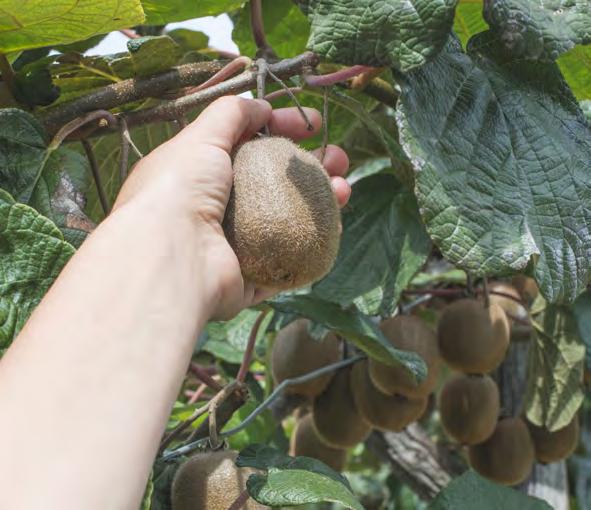
while juggling absences due to covid infection and isolation requirements.
Call going out to locals for support
He had put out a call to any locals keen to help out over the busy period.
“We got a number who were prepared to lean in to help which was fantastic, but they were really only a sprinkle of what is needed.”
He suspected the local labour pool has been well and truly mined for staff. The higher labour costs were also prompting operators to look even harder at where automation may play a role with crop growth expected to continue in coming years.
His company had invested $5.5 million in the past year to automate one of its lines, but there was lag of two years between planning and
Veros are starting April with exciting news, announcing the appointment of two new standout shareholding partners, Julie Price and Stephen Cornwall, who join their leadership team. The appointments build on the depth and unique skill set of the team at Veros as the company grows and increases its capability across the property sector of New Zealand.
“We’re delighted to announce these latest appointments that recognise the leadership and skills of Julie and Stephen, signalling another special milestone as a company,” says Managing Director, Morgan Jones. “Since joining our team in 2019 both Julie and Stephen have grown to be impressive leaders, who exemplify our company values and culture in their approach to work. They have
become invaluable members of our team.”
Both born and bred in Rotorua, growing up in provincial New Zealand, Julie and Stephen have in common a genuine investment in the growth and success stories of our regions.
At the heart of what Veros do is connect clients with experienced people who know what they are doing and can partner with them to help them achieve their project goals. Julie and Stephen live and breathe the company ethos in bringing a genuine and authentic approach to projects to deliver the best outcome for each project.
Stephen has become a key player in the development management team, working across some very complex and large land development proj-
ects. Stephen’s strength is his ability to bring together a team whilst simultaneously driving them to deliver outstanding results. With his experience, he understands the technical side of land development which helps to drive solutions and cost savings for projects. “Stephen is extremely hard working and will be the first to put his hand up to lead initiatives that support our team and drive our culture, so it feels a natural step that we welcome him to the leadership team.”
With her recent promotion to Senior Project Manager, Julie is a super effective and hardworking leader within the project management team and beyond. She works effectively across projects, pulling together teams on large and complex projects. Julie operates successfully to overcome challenges and chase
commissioning such equipment. “It is tough on capital and the costs only keep going up.”
Derek Masters, chief executive of DMS Progrowers said he was confident this year’s crop would all be picked, but not all necessarily at its optimum, given labour shortages. “It often does not matter how much you pay, the people just are not there,” he says. His company are now offering free meals to staff at the start of shifts, a strong drawcard for many. “That is 300 meals a day, and a six-figure addition to our operating expenses.”
While DMS has got its contingent of Samoan RSE workers, he knew of several post-harvest processors who were short, and he believed government had acted too late in allowing many of those workers back in time to meet harvest deadlines.

shifting goalposts on projects in the public eye, which is not easily done.
“I’m always pleased to hear from clients of their high regard for Julie and her work.”
Veros work across the growth and development spectrum of regional New Zealand including development management, project management, property advisory, and strategic projects. Morgan says the addition of

Julie and Stephen strengthens our service delivery capacity and capability. “We are delighted to welcome Julie and Stephen into their new roles in our leadership group, and we congratulate them on these appointments. These two have a passion for delivering excellent results for clients and are leading some of the most exciting projects currently underway across New Zealand.”
On 5 April 2022, the Commerce Amendment Act 2022 received Royal Assent. The purpose of the Act is “to strengthen the prohibition [in the Commerce Act 1986] against misuse of market power and make other changes to improve the functioning of the Act”.i

> BY BEN CAIN
Ben Cain is a Senior Associate at James & Wells and a Resolution Institute-accredited mediator. He can be contacted at 07 928 4470 (Tauranga), 07 957 5660 (Hamilton), and benc@jaws.co.nz.
P owners need to take note of the Amendment Act because as well as beefing up the current prohibition against taking advantage of market power in section 36 of the Commerce Act, the Amendment Act also removes significant benefits currently in place for IP rights holders.
The current legislation
The current Commerce Act contains three provisions which specifically benefit IP rights holders.
The first provision is section 7 – Section 7(2) provides that nothing in the Commerce Act “limits or affects any rule of law relating to breaches of confidence”, while section 7(3) provides that “no law relating to breaches of confidence affects the interpretation of any of the provisions of the Act”.
In other words, owners of confidential information are at liberty to pursue breaches of
confidence without any regard as to whether their pursuit is or could be contrary to the Commerce Act.
The second provision is section 36 – Section 36 currently states that a person that has a substantial degree of power in a market must not take advantage of that power for the purpose of restricting the entry of a person into that or any other market, preventing or deterring a person from engaging in competitive conduct in that or any other market, or eliminating a person from that or any other market.
IP rights holders won’t be liable under section 36, however, if all they are doing is seeking to enforce a statutory IP right.ii
The third provision is section 45 – Section 45, broadly speaking, benefits IP rights holders by exempting the granting of IP licences (or, to use the statutory language, the entering into of a contract
or arrangement or arriving at an understanding) from the provisions of the Commerce Act that relate to cartels and anti-competitive agreements.
The new legislation
The Commerce Amendment Act sweeps all of these benefits away.
No more will IP rights holders’ activities be shielded by the legislation, away from the prying eyes of competitors or the Commerce Commission.
There is no need for immediate panic. While many of the amendments to the Commerce Act will come into effect on 5 April 2023, there is a oneyear transitional (or “grace”) period for the exemption of IP rights from provisions relating to cartels and anti-competitive agreements for arrangements entered into or arrived at before 5 April 2023.
This is not to say that businesses that may be affected by
the changes to the Commerce Act should sit on their hands: on the contrary, they should seek to review their contracts, arrangements or understandings as soon as practically possible.
The commercial entities which are likely to be most affected (and concerned) by these changes are, of course, those who wield substantial power in their markets.
Businesses in this position may find themselves unable to enforce their patent or plant variety rights, for example, if doing so would have the likely effect of substantially lessening competition in their markets.
At the very least, such businesses are likely to be faced with allegations of anti-competitive behaviour.
When this occurs (and undoubtedly it will), IP rights holders may well ask their IP attorneys, “What was the point of obtaining IP protection in the first place? If I can’t enforce my IP rights, what incentive is there for me to continue to innovate?”
These are troubling questions and ones to which IP attorneys up and down New Zealand do not yet know the answers.

Generation Homes is proud to announce it has joined the Whānau Āwhina Plunket family of sponsors.
“Generation Homes’ purpose is to build homes for generations and everything Whānau Āwhina Plunket does is to support Kiwi whānau and their tamariki to thrive, so this sponsorship is a perfect fit for our communities,” says chief executive Kevin Atkinson.
The national sponsorship partners Whānau Āwhina Plunket with Generation Homes in the eight regions where its new homes are being created for families – covering Northland, Auckland North, Auckland South, Waikato North, Waikato Central, Bay of Plenty, Taupo, Rotorua and Kawerau, and Christchurch.
“Many of our customers are young families and we give them a place to call home, establishing neighbourhoods where children grow up in warm and safe houses, in fun, healthy and connected communities we have helped shape where children can flourish,” says Mr Atkinson.
“Supporting Whānau Āwhina Plunket is an important sponsorship for us as Generation Homes is built upon family values.
“One of our company values is to muck in and play our part – offering support, advice, and working with others to get the job done. That resounds with what the Plunket team is doing every day for thousands of Kiwi families,” he says.
Generation Homes will give families a small gift of baby milestone cards covering the special moments from 1 month to 1 year as part of their initial Plunket Well Child check.
Whānau Āwhina Plunket chief executive, Amanda Malu, is thrilled to have the support of Generation Homes.
“We are all about making sure whānau are thriving, and we are delighted to have Generation Homes on board as a generous sponsor. The Covid-19 pandemic has been tough on charities and this is welcome news for us,” she says.
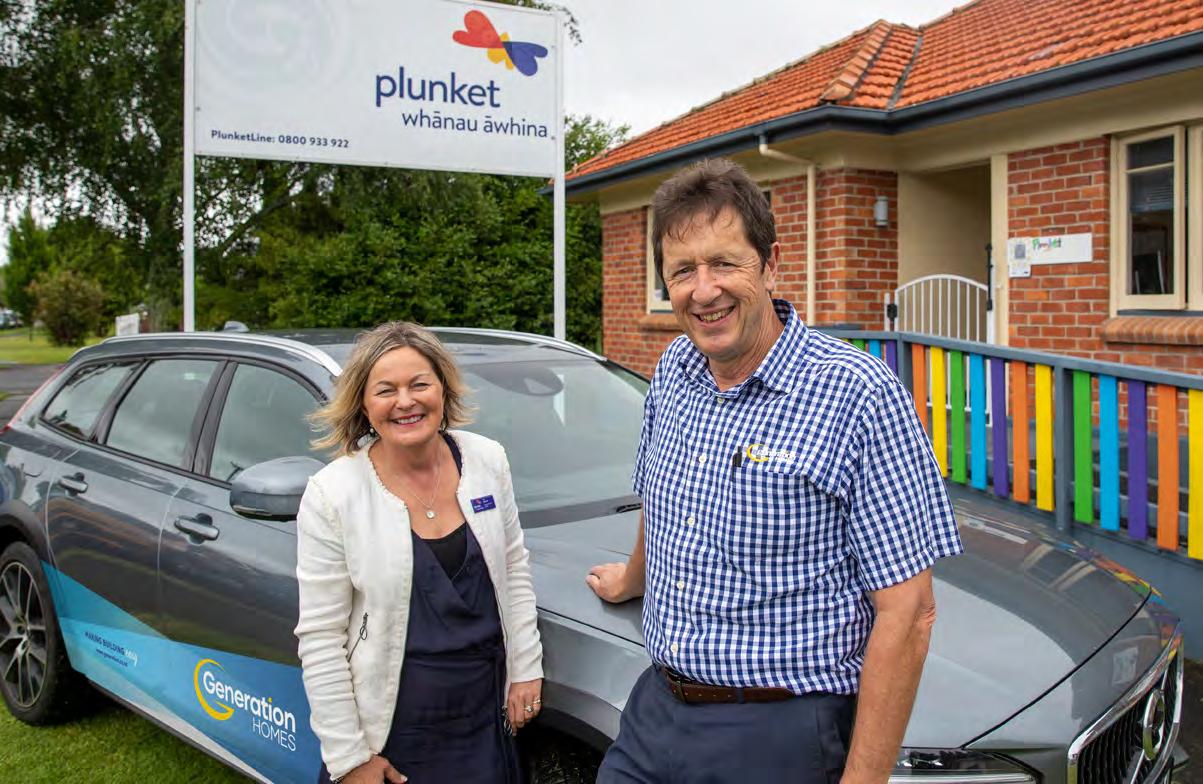
“The support from Generation Homes helps make sure Whānau Āwhina Plunket can continue to be a steady, compassionate presence for families, whānau, and caregivers, in person, virtually, or by phone.”
Mrs Malu says this includes

Moving into Orange for Easter was a tremendous boost for Trustpower Baypark. Just in time for Speedway and the end of season Fireworks Display on Easter Saturday. Great weather and a big crowd all enjoying the atmosphere.
The feeling of relief from Event Organisers and Promoters is profound. After months of uncertainty, with the usual packed calendar of events held back with the red restrictions – these can now happen. From May Baypark will again host a variety of interesting events for the community with no limitations on capacities.
Ball Season
Trustpower Baypark welcomes back the School Ball Season in May.
Mount Maunganui College Ball 2022 – 14 May
Another year, another school ball! Mount Maunganui College Ball is the foremost social occasion of the year for Year’s 12 and 13 students. As it is the first school ball for many of the students, getting amongst the excitement is the name of the game. The prospect of living out a red-carpet fantasy and bringing the Prom Night trope to life is an exciting whirlwind for high schoolers.
Otumoetai College Ball 2022 –21 May
One of the most anticipated events on any high school calendar is the Otumoetai College Ball. A huge effort has gone into ensuring this event is spectacular and will leave a lasting impression on all year 12 and 13 students in their last year of School
The Bay of Plenty Wedding Show – 29 May
Planning your wedding is a beautiful, fun experience so come along to The Bay of Plenty Wedding Show and be inspired. There are loads of gorgeous ideas, on-trend inspiration, meet amazing wedding vendors who can help you plan the most amazing day of your life. Take the time to browse and speak to them, as they have a wealth of experience on offer. There will be giveaways and event day specials from our wedding specialists and
a wonderful fashion show where you can view the amazing wedding gowns, bridesmaid gowns and menswear coming down the runway at 2.00pm.
Soak up the atmosphere and experience the fun, excitement, and glamour as all the top wedding specialists in the region gather at the Trust Power Arena, Mt Maunganui.

For more information visit www. thebayofplentyweddingshow.co.nz
Wheelchair Rugby Tournament Round 1 – 11-12 June
Parafed Bay of Plenty, in conjunction with New Zealand Wheelchair Rugby (NZWR) are pleased to be hosting the first round of the Wheelchair Rugby Competition (WRC1). Players and teams will get a measure of their opposition, their strategies and game plans in preparation for Round two in July.
NZWR’s Officials run NZ Wheelchair Rugby tournament. Official Volunteers are Referees, Classifiers and Bench staff. All roles are trained through a pathway developing individuals from domestic level to international level recognised qualifications. Wheelchair rugby is a game to be enjoyed by everyone and there is a role for everyone.
7 Days Live – 19 June
7 Days on TV is pretty loose and real, but 7 Days LIVE – on stage with no cameras, censors or editing – is a whole different level of uncut fun. This June, in your town, see Jeremy Corbett, Dai Henwood, Justine Smith, Paul Ego, Ben Hurley, Mel Bracewell and the team on a stage right in front of you.
In the first half, seven of New Zealand’s best comedians take turns to smash you with their best stand-up comedy, then it’s a no-holds barred live version of 7 Days. It’s a show that you won’t forget. Recommended for ages 15+.

For more information visit https://premier.tick etek.co.nz/shows/show. aspx?sh=7DAYS2021

Armageddon – 23-24 July
The Tauranga Armageddon Expo is back with two days of gaming, cosplay, anime, collectables, comics, amusements, celebrity guests, movies, television, music and more! Experience the incredible with Armageddon! Follow the Armageddon Expo Facebook, Twitter and Instagram for updates – links and details on the Armageddon Expo website.
Battle in the Bay – 6-7 August
Battle in the Bay 2022 Cheer Championships – Watch the amazing talents of some of the best Cheerleaders across the country.
Cheerleading is one of the fastest growing sports in NZ. Cheerleaders come together to compete at the amazing Trustpower Arena and in the beautiful surrounds of Mount Maunganui
Tauranga Careers & Business Expo – 12-13 August
Thousands of students, job seekers and those looking to upskill or change career are expected to descend on Trustpower Arena for the Tauranga Careers & Business Expo in 2022.
The annual Tauranga Canvas Careers Expo aims to give people the opportunity to explore their options.

interactive displays and representatives from across New Zealand, ready to engage and help students and adults alike plan their career pathways.
With over 60 exhibitors from local businesses and tertiary study and training providers involved, 3000 Bay secondary school students will be welcomed through the doors.
Expo organiser Sue Boyne said: “It’s great to see this event return to Baypark, an excellent facility with flexible and responsive staff who make the execution of such a largescale event a dream.”
Enquiries welcome from local businesses about how to get involved as exhibitors – please contact Andy Howells, Instep Manager at andy@ priorityone.co.nz.
As co-hosts of the event, Priority One sees the expo as a great opportunity to better prepare students for the real world. Instep manager Andy Howells says the reality is that we don’t know what new jobs may exist 5-10 years from now.
Baystation offers adrenaline-pumping fun for the young and the young at heart with four action packed activities in one great location.
Live out your Tokyo Drift fantasies on the electric Drift Trikes or combine the very best of go karts and sail boats to give you the ultimate land-sailing experience on the Blokarts. For high-speed, adrenaline-filled action you can’t go past Paintball, or if you are looking for something a little less messy try out the outdoor Laser Tag. Combine our epic activities for the ultimate day out, perfect for birthdays, staff functions and events.
Tauranga’s Premier Venue
Trustpower Baypark is Tauranga’s Premier Venue for conferences, meetings, entertainment, and exhibitions. Offering a complete package in one convenient location that features state of the art meeting rooms, in-house catering, audio visual services, marketing/promotional services.

“You’ve got to know when to hold ‘em, know when to fold ‘em, know when to walk away. And know when to run...”
These immortal words contained within Kenny Rogers 1978 hit song
The Gambler may not have been written about business, but the words certainly have a relevance to the business landscape at this time.
Our national attitude of perseverance and determination are a real source of pride for us as kiwis, but when pushed too far this attitude can be dangerous and sometimes fatal.
As a credit consultant I am often called in too late to a business where, not only the wheels have fallen off, but also the hubs, axles and the chassis is dragging on the ground.
Undeterred, the owner tells me that if they could only get a bit of funding they will be able
to get through the struggle and make business great again.
Now there are instances where this is true – for example when an unforeseen event like Covid or an earthquake occurs and the “business as usual” model is not effective for a period of time.
In many cases this is not so and the short-term fix will not correct the long-term problems. Systemic business issues will often be more obvious in times of stress or turmoil, but this just highlights problems that are already there.
The solution isn’t always working more
Rather than analyse and address the issues, often busi-
ness owners think that they just need to work more and find more clients.
If your business issues are ones such as miscalculated margins or badly managed projects these will only be made worse by volume.
Upscaling profits and upscaling problems often look the same from an input perspective, but are vastly different from an output one if the underlying issues are not found and corrected.
Having an impartial business advisor or mentor look over your systems and processes periodically could point these problem areas out before they become business killers.
Often however I am called in after the issues have grown

> BY NICK KERR
Nick Kerr is Regional manager for DebtFree NZ ltd and director of International Private Investigations Ltd. He can be reached
into monsters and the overworked owner is putting massive effort into putting out fires and a decision must be made; do they carry on working themselves half to death until someone else such as the IRD or an unpaid creditor decides it is time for them to stop through a liquidation.
Or do they pause, see the situation for what it is and make an exit plan that leaves them intact from a financial and reputational perspective.
In business people have long memories and bowing out
gracefully without a legion of unpaid creditors and crippling personal debt is a hell of a lot easier to come back from than the alternative.
Loans given to struggling businesses are nearly always very high in interest and given the probably insolvent position of the applicant business, loans will be secured with at the very least a personal guarantee and probably a security over personal assets such as property.
I have seen business owners lose houses, go bankrupt and have their lives ruined, I
have even seen a few very sad cases where the business owners took their own lives for simply not knowing when to call it quits.
If you are ever in the position where the options are to cease business or go all in with everything you have, take some time with an independent advisor that can give you the cold hard facts regarding the business’ real-world chances of survival before you take the leap. Your life may very well depend on it. Just a thought.
On 1 April the minimum wage increased to $21.20 per hour and it was no April fools joke. With both businesses and employees currently struggling with increasing costs, finding a balance is a difficult task. With many businesses saying we have gone too far and employees and unions saying we haven’t yet come far enough. Is the new minimum that balance?
Every year, by law, the minimum wage is revised by the government. This doesn’t always amount to much, but they take in multiple factors to ensure the balance can be found between economic growth and support of those on low incomes.
Under the National Government earlier in the decade we typically saw this rise at 3-4 percent on the previous year, but since Labour has been in government this typically sits on a 6-7 percent increase per year. This year sees a 6 percent increase on minimum wage in line with inflation, taking it from $20 up to $21.20 per hour.
To put this into more understandable measures, an employee on the minimum wage working 40 hours per week, will see an increase of $48 on their pay packet per week or $2496 annually.
Although a significant increase, this is still shy of the $22.75 considered the living wage. The living wage is a voluntary concept, simply the hourly wage a worker needs to be paid to afford the necessities of life and participate as an active citizen in the community.
This concept was a response to the growing poverty and inequality that many New Zealanders suffer. Members of the living wage movement believe striving for a living wage for all households is a necessary and important step in the reduction of poverty in New Zealand.
The Government has taken on support of the living wage concept and is offering this for all of their public service contractors.
Michael Woods, Minister for Workplace Relations and Safety, stated in his February
public service contractors”.
According to MBIE there are currently estimated to be just over 160,000 recipients of the Minimum wage throughout New Zealand.
However, the Government is stating that this will likely affect up to 300,000 New Zealanders, with others in the next wage brackets also receiving a bump up so as to be in line and relative to the new minimum.
What does it mean?
So, what does this all mean for businesses fitting the bill
Members of the living wage movement believe striving for a living wage for all households is a necessary and important step in the reduction of poverty in New Zealand.
11 announcement about the rise, “minimum wage is one of the many tools we’re using to support those on low incomes including the implementation of fair pay agreements and extending the living wage to


ity and profitability.
> BY KELLIE
HAMLETT
Talent ID are Recruitment Specialists and can support you through your recruitment process. Please feel free to talk to us about this by calling 07 349 1081 or emailing kellie@talentid.co.nz
Yes, it will affect the bottom line especially in the short term. However, the bonus comes with the extra money in people’s pockets, which should flow on to additional spending and thus create a positive economic outcome.
Additionally, employees that are paid well feel valued and this can increase productivity and loyalty from staff.
for these 300,000 New Zealanders? Is this all doom and gloom?
Some are describing it as a kick in the guts, especially given the timing with Covid outbreaks effecting productiv-
Research has shown a minimum wage increase can improve the productivity of an organisations workforce with higher wages reducing turnover. With evidence showing that higher minimum wages
lead to a stable and experienced workforce, an organisation can reduce costs on recruitment and initial training that are known to be well over the cost of the additional wage.
By paying a higher wage, businesses also reap the benefits of employees who can focus more on work and are less distracted by the demands of poverty, like how they will afford to pay their rent or put food on the table.
Giving employees a decent remuneration for their time and contribution to the organization should be key to a business.
Cutting costs in this area,
will ultimately cost much more in other areas, such as recruitment and training due to high turn-over and low productivity. Businesses that successfully navigate minimum wage increases often find themselves in an economically healthy environment, with customers having more income to spend on goods and services. They also have employees who are happier, productive and more loyal workers. This minimum wage increase doesn’t have to be a kick in the guts; it can instead be a benefit for both business and employees alike.
Franchise management trends and perhaps sensitivity around the emotion evoked by the word have seen The C Word being used less and less by franchisors and in franchise circles. By many it is seen literally as a dirty word and not mentioned.
The Big C Word is of course – Compliance
Over recent years the use of the word “Compliance” and even “compliance audits” have been relabelled, downplayed, and even purposely neglected by many franchisors and those managing franchise systems.
The rationale by many franchisors is to avoid conflict and friction with franchisees. The Compliance word and auditing process has been replaced with a plethora of terms, including business development meetings, system reviews, or perhaps business audits. The commonality being the non-use of The C Word – Compliance.
Is it time to call it what it is and proudly bring back The C Word – Compliance? Personally, I believe it is in the best interests of all involved in franchising that system and franchisee management that
there should be a real focus and championing of Compliance. Here’s a few other C Words as to why.
Franchising is based on delivering another C word, consistency. Traditional franchise system management focused and revolving around compliance and or compliance auditing of franchisees.
All the business data, dashboards and profit and loss statements in the world will not identify if a particular franchisee is operating their business according to brand standards.
They could have a great business, but not a great franchise. Only and solely by directly auditing and evaluating the operations against brand standards will consistency be checked, measured and managed.
Franchising relies heavily on commitment. Commitment on the part of the franchisor to maintain and develop the system, processes, products and support of the franchisees.
Commitment on the part of the franchisee to follow the system and processes. An old argument from non-compliant franchisees is that they need to “step outside the system” to make money, or that they could do something better than the system. The reality is that they are not committed to the franchise system.
Good franchise systems are not static, they do change over time and franchisee ideas are incorporated and developed, but no good system can have franchisees doing whatever, whenever. Equally franchisors
Recently, Toi Ohomai Institute of Technology (Toi Ohomai), the largest tertiary education provider in the Bay of Plenty and South Waikato launched its new co-brand with Te Pūkenga –Aotearoa’s new national vocational education provider.
The new co-brand forms part of the engagement process as Toi Ohomai, along with all 15 Institute of Technology and Polytechnics (ITPs) across Aotearoa, transition into the new national entity.
This work will see the
Toi Ohomai logo sit alongside the Te Pūkenga logo until early 2023, when Toi Ohomai will officially become Te Pūkenga.
As part of the brand transition, Te Pūkenga will launch the brand on a national scale in August.
The establishment of a singular ITP network is part of the Reform of Vocational Education (RoVE). It is the most significant change seen by the tertiary education sector in more than 25 years.
Toi Ohomai Chief Execu-
tive Dr Leon Fourie says that while the Toi Ohomai brand may be changing, our commitment to providing quality, innovative education that meets the needs of our region won’t change.
“Our whānau just got bigger. Being part of such an extensive network will enable us to draw on national strengths that will further benefit our communities. Te Pūkenga is focused on regional success.”
The Toi Ohomai name was gifted by iwi to the institute
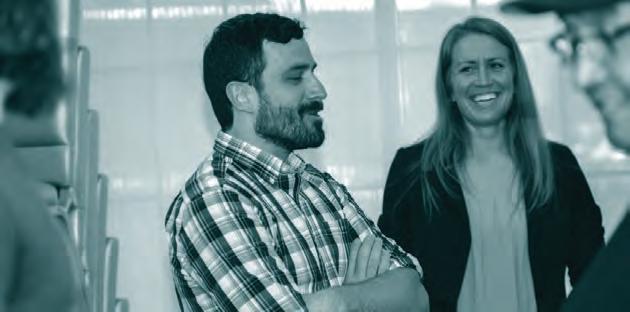
“This course has helped me with my confidence as the skills discussed and demonstrated were ones I use regularly, however felt I was not using well. I have also started improving on my people skills and communication skills and acknowledge that this is an ongoing activity. Thank you for a fantastic programme!”
– Project Coordinator IT Infrastructure Company Hamilton


> BY NATHAN BONNEY
Nathan Bonney is a director of Iridium Partners. He can be reached at nathan@iridium.net.nz or 0275-393-022
cannot be successful or introduce change or even maintain compliance without cooperation. Change, evaluation and even failure with-in a system is successfully undertaken and navigated by cooperation between franchisees and franchisors. If there is not cooperation, I would argue there isn’t commitment and almost certainly there won’t be compliance.
Consumers have expectations and will often make decisions based on brand and the belief that a brand will deliver on their expectations. If a particular franchisee or business unit does not meet the expectation of the consumer against known brand standards, it’s highly likely that they will not be satisfied. The impact is not
limited to the individual business unit or franchisee, but to the brand overall. In franchising, compliance is a result of a number of factors aligning including mutual commitment, cooperation and consistency – something that franchisors and franchisees alike should strive for, be proud of and most importantly be willing to call it and measure it.

in 2016, as part of the merger of Waiariki Institute of Technology and Bay of Plenty Polytechnic. Te Pūkenga, alongside
Ohomai, acknowledge the significance of this gift and are committed to working closely with iwi and
At Dale Carnegie, we help people from all walks of life become fearless. Whether they’re starting out or stepping up, we sharpen their inner voice so they can use it with confidence to get the most out of their life and their work.
Our programmes show people how to communicate in a way that draws others in so they can form closer, more rewarding relationships in their personal and professional lives. As they gain greater influence with the people around them, they’ll come face to face with more opportunities to make meaningful contributions in the places that matter most.
Dale Carnegie BOP Waikato 07 579 0484
www.bop-waikato.dalecarnegie.com
Evan and Linda Potter, of Central Hawke’s Bay hill country property, Waipapa, (sheep, beef and deer) are the new National Ambassadors for Sustainable Farming and Growing and the recipients of the Gordon Stephenson Trophy.
The award announcement was made recently at the National Sustainability Showcase at Te Papa,Wellington, attended by all of the regional supreme winners from the 2020 Ballance Farm Environment Awards. The BFEA is an annual celebration and promotion of sustainable farming and growing practices, where regional supreme winners come together to share ideas and information.
Ballance is headquartered in Tauranga. And the couple recently visited the head office to present to Ballance staff the thinking around their farming practices, how they lead in sustainability and their journey and experience in the BFEA awards and as ambassadors. Their visit also included their potential advice to future applicants.
The Potters bought Waipapa in 1997 and set to work transforming what they described as a blank canvas
into an aesthetically pleasing and productive business producing venison, velvet, wool, sheep and beef off this 740 ha property.
There is a focus on biodiversity and trees with 22 percent of their farm retired into mainly QEII National Trust covenants and plans to continue fencing and retirement of more land in partnership with QEII.
Other initiatives include an annual pole planting programme for shade and erosion control, planting of natives, regular possum, cat and pest control, and wetland and riparian planting.
The Potter’s focus on solutions and their understanding of the need to maintain sound financial performance to fund environmental projects was a stand out for the National Judging Panel. Judges noted that the owners presented well-articulated, positive and holistic views about New Zealand and its future as a food and fibre pro-
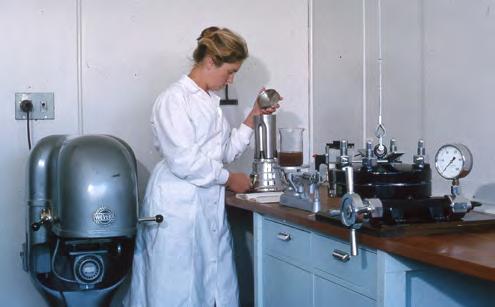
ducer on the international stage. Judges noted they both have an excellent understanding of on and off farm challenges faced by the sector. Along with impressive biodiversity, they have also diversified their income stream from livestock across sheep, beef and deer, farmed for velvet.
They chose to enter the Ballance Farm Environment Awards because of their passion for the environment and to share their story.
“We want to get around the table and have an impact and not just be by-standers,” said Evan Potter. “We realised we have a story to share and hope that it can inspire others on their journey.”
Both Linda and Evan have been heavily involved with their local community and have developed a strong partnership with their regional council.
Chair of the National Judging

Panel, Dianne Kidd said: “On behalf of the judges of the Gordon Stephenson Trophy, I would like to congratulate Evan and Linda Potter. The Potter’s demonstrate a sound understanding of industry metrics around key topics of climate change and reducing greenhouse gases. They certainly ‘walk the talk’ with their environmental projects and sustainability initiatives. They are role models as early adopters of change.
“Evan and Linda have an obvious love of farming and a pride in the successful business they have built together over the last 23 years. They are practical and sustainable and tell a very good story that many others will learn from.”

The Awards are run by the New Zealand Farm Environment Trust, a charity dedicated to promoting leadership in environmental excellence and encouraging the uptake of management practices which both protect and enhance the environment and add value to farming businesses and communities.
Each year, the Ballance Farm Environment Awards’ regional ceremonies, the National Sustainability Showcase, and regional supreme winners’ field days offer a unique, pan-sector forum for networking and the sharing of ideas and information among farming/grower peers, agribusiness professionals and the wider community.

This year, the Crown Research Institute (CRI) turns 75 and continues to deliver impact for New Zealand, not just across the forestry sector, but also in the area of biomaterials, bioenergy, waste and ecosystem services. This evolution represents the increasing importance of forests, and Scion’s commitment to enhancing New Zealand’s prosperity, wellbeing and environment through trees.
In April 1947, the State Forest Service established a Forest Experiment Station beside the existing nursery at Whakarewarewa Forest. The decision to centralise forestry research laid the foundation for Scion today, supporting New Zealand’s third largest export industry.
Scion’s research has had significant outcomes for New Zealand’s 1.7 million hectares of planted forests. Forestry adds $6 to $7 billion to the economy each year in export revenue and provides jobs for around 35,000 people.
Scion’s chief executive Dr Julian Elder says the 75th anniversary is a chance to reflect on where the organisation has come from and where it is headed, but also to really acknowledge the place that Scion sits right now –quite literally, the land on which the institute was built.
“When we opened our award-winning innovation hub, Te Whare Nui o Tuteata, in March last year, we started
on a journey of inviting visitors into Te Papa Tipu campus, where Scion is headquartered in Rotorua, and sharing our work with the community.
“A significant and very special part of that journey has been the relationships we have developed with Ngā Hapū e Toru - Ngāti Hurungaterangi, Ngāti Taeotu and Ngāti Te Kahu o Ngāti Whakaue.”
Ngā Hapū e Toru are the mana whenua of the 114 hectare site where Scion is situated in the Te Papa Tipu campus.
Ngā Hapū e Toru trustee Veronica Butterworth explains that when the land was used by the Crown as a forest nursery from 1898 and then for forestry research from 1947 onwards, physical connection of the hapū to this land was severed but the spiritual connection was never lost.
“Land is the basis of identity and wellbeing for our people,” Veronica says. “We are genealogically connected through our whakapapa to the land itself, as we trace our ancestry from Papatūānuku (the earth mother) and Ranginui (the sky father).
“Our whakapapa ties to the land and the various parts of the natural environment are fundamental aspects of our culture and our lives. Whakapapa and whanaungatanga give rise to obligations to look after the land, the waters and the environment on behalf of our ancestors and ourselves for future generations.”
Since it was established in 1947, the Forest Research Institute, which we now call Scion, has played a significant role in forest research for New Zealand.
“Looking to the future, our hapū are building a relationship with Scion to reconnect our people and traditions to this land. The name of this campus, Te Papa Tipu – land on which to grow – is appropriate,” Butterworth says.
It is this kaitiakitanga (guardianship) for the land, and the long-term thinking that Māori value – making changes today that will reap benefits for generations to come – that Dr Elder says is key to Scion’s contribution as we head towards a circular bioeconomy future.
“Right now, we are on the cusp of huge opportunities with the circular bioeconomy. Scion, and New Zealand, are incredibly well-placed to contribute to this – we grow things well, we’re great at the science and, vitally, mātauranga Māori and the worldview of te ao Māori has much to teach us about interconnectedness with our environment.”
For principal scientist, Brian Richardson, celebrating 75 years of Scion is a chance to acknowledge the high-calibre breadth of work that has been achieved over that time.
Dr Richardson has worked at Scion for 39 years across many areas of forest science. In that time, he has seen a lot of changes – and a lot of things come back around. The highlights across the organisation have been many - genetic improvement of radiata pine, overcoming many forest health challenges and biosecurity
incursions, supporting development of sustainable forest management practices to ensure maintenance of productivity and license to operate, and creation of management models.
“Scion has certainly been a leader across a range of research. Our work in areas such as ecosystem services – quantifying the benefits of forests beyond the timber – were happening long before the topics were accepted as mainstream activities.”
Doug Gaunt is a principal researcher in the materials analysis, characterisation and testing team. He joined Scion in 1979 and says the organisation’s contribution to the structural timber sector has been transformational.
Gaunt and his team focus on commercial testing for the timber building sector, supplying customers with the information they need to develop their own products and to meet export standards.
“Scion has been doing this work extensively for 40 or 50 years and I’d like to think that our research and expertise has impacted most building products in New Zealand. That is a huge testament to the work that has been conducted in our timber engineering labs.
Reflecting on Scion’s history, some other key areas of work have included climate change, including research around how our fast-growing forests are adept at capturing carbon quickly.
Trees provide a long-term carbon sink while protecting New Zealand’s unique biodiversity, water quality and help reduce soil erosion. These are not just important for our economy, they are crucial for life.
Significant achievements across 75 years have built Scion’s reputation as a world-leader in forest industry research and technology development. Now we have a distinct multi-disciplinary capability across the value chain from germplasm generation to the design and application of wood, fibre and other forest resources in commercial products and services. In 2000, Scion extended its focus to developing renewable chemicals, materials and energy from forest resources. These changes reflected increasing international interest in substitutes for fuels and materials made from fossil fuels and New Zealand’s need to enhance environmental performance and energy security. These concerns are much greater today as the world has suffered supply chain shocks due to Covid-19, conflict and climate change.
Scion has more than 300 staff located at its headquarters in Rotorua, as well as offices in Christchurch and Wellington. Over the next 12 months, a range of activities and events will be held online and across the three cities as the organisation celebrates the 75th anniversary.
Priority One called Western Bay of Plenty’s young, bright minds to attend the virtual launch of the 2022 Young Innovator Awards (yia!) in March.
Students, parents, teachers, and local businesses were encouraged to attend the online event to hear about what’s involved in the programme and how they could benefit from taking part – either as a student entry or as a business looking to get involved with the programme.
Coveted as one of the highlights on the school calendar, yia! offers local students from Years 7 – 13 the hands-on chance to develop an innovative product or service that solves real-world problems.
Top entries win internships with local businesses, giving students the chance to gain valuable workplace experience and engagement, and insights to take their innovations to the next level.
This year, Priority One is aiming to recognise as many entries as possible by increasing the number of opportunities for workplace experience

and is looking for more businesses to come on board to offer this.
“No matter how big or small your business is, the benefits of participating in the yia! programme are two-fold,” says Andy Howells Priority One’s Instep Manager.
“Businesses are using yia! as a talent attraction tool when recruiting from outside the region, it’s appealing to parents with school aged children who could benefit from the exposure to design thinking and innovation,” he says.
“Being involved as a busi-
ness also provides team members with valuable experience too – exposing them to young minds keeps the creative juices flowing – and that’s what it’s all about.”
Engineering firm, Beca, has been on board with yia! for several years and has seen the
Being involved as a business also provides team members with valuable experience too – exposing them to young minds keeps the creative juices flowing – and that’s what it’s all about.”
benefits of the programme.
“In a rapidly changing world our ability to keep pace as a business is directly proportional to the influence of our next generation,” says Beca Digital Consultant, Jeremy Wright.
“Where young people are provided with the opportunity to have that influence and share their perspective, businesses have an equal opportunity to learn and adapt.”
Tauranga City Council’s Community Development team came on board for the first time in 2021 and its Team Leader, Dani Jurgeleit, encourages organisations that embrace innovation to support the programme.
“It was a privilege for us to be a sponsor in 2021. The insight, passion and effort demonstrated by our rangatahi in their well-considered entries showed an incredible commit-
ment to the social, cultural and environmental wellbeing of our communities,” she says.
Aquinas College yia! teacher, Jenny Livingstone, is a big fan of the programme, saying that it has been life changing for some of her students.
“Our students have begun to see themselves as genuine innovators and have realised that their ideas are not just another school project, but good enough to develop into a saleable product,” says Jenny.
“Also, many had not realised there are so many great career opportunities with innovative companies in the Western Bay, like Robotics Plus and Ram 3D – right on their doorstep.”
The submission deadline is 1 July, with judging and shortlisting commencing, all culminating in the award night on 1 September.

New Zealand fresh produce software provider Radford Software has onboarded leading Australian asparagus producer and distributor Raffa Fields to implement a packhouse system entirely remotely.
Customer success manager Royce Sharplin said the partnership represented two key firsts for Radfords – a move into the asparagus sector and the first remote implementation of its packhouse solutions, due to the global pandemic.
“This reaffirms that our strategy to diversify into wider fresh produce sectors to complement our traditional kiwifruit, apple, citrus and avocado markets is on the right track,” Mr Sharplin said.
“It would have taken a lot of trust to implement our systems from afar. Go-live last August followed a condensed timeframe from scope to delivery, achieved by a strong partnership with an enthusiastic and proactive team from Raffa Fields.”
He said “out-of-the-box” traceability, grading and inventory management solution, FreshPack and quality control-focused application FreshQuality were launched at Raffa Fields’ Victorian packhouse in time for the 2021 spring harvest.
Radfords’ product owner Nick Eggmann said FreshPack had evolved in the years since its development to be “produce-agnostic”, allowing any producer to adopt it without customisation beyond minor configuration to suit individual workflows.
“More than 80 fresh produce packhouses around the world are now using FreshPack. As it is off-the-shelf, the only modification made for Raffa Fields (after go-live) was to integrate
scales to record weight crates at the time of receival,” Mr Eggmann said.
“Traceability was a key objective for Raffa Fields. They needed a system that provided good inventory and stock control from harvesting to distribution and helped them move away from handwritten notes and duplication of data.
“Raffa Fields really needed our solutions to work. They could see the benefits and worked hard to help us make it happen. There was a certain onus on the Raffa team to ensure they had done the testing and knew how to execute the process so when asparagus arrived at the packhouse, there were no surprises.
“The biggest challenge for us was not being on the ground at crucial stages of the 12-week project. We had to rely on information provided to be correct – everything from the layout of the packhouse to how the business worked. It required constant and clear communication and documentation.
Raffa Fields’ willingness to invest in the process made the project successful,” Mr Eggmann said.
Software provides opportunities for growth
Family owned and operated Raffa Fields is one of the three largest asparagus producers in Australia. Annually, it produces some 2,000 tonnes of premium asparagus in the Koo Wee Rup region for domestic and export

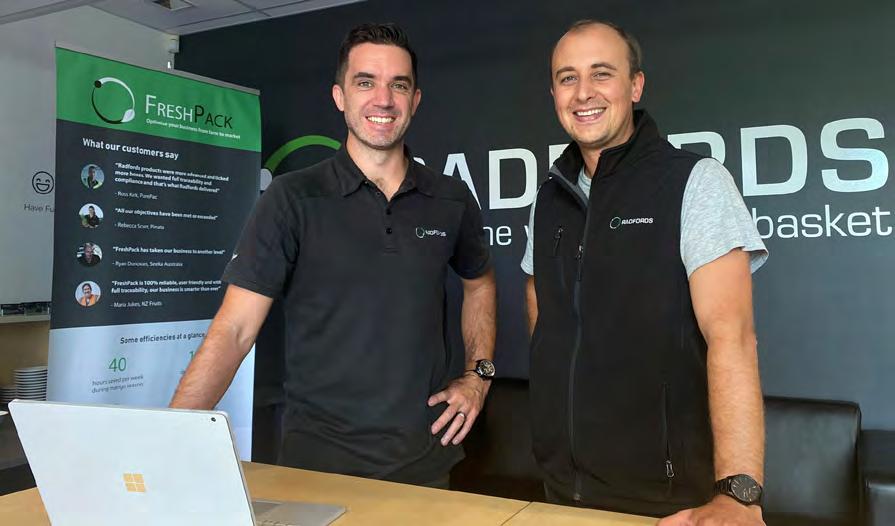
consumption and distributes imported asparagus during its off-season.
Sales and operations manager Rosalee Raffa said the software had transformed packhouse operations and created multiple efficiencies, saving the sales and logistics team up to five hours a day.
“Two years ago we began supplying direct to Coles, which gave us the opportunity to also run an import program. Between this and our local production process, our custom-built software solution was not keeping up with our needs. By April last year, we were in dire straits and asparagus season was approaching. We were looking for an end-to-end solution that could handle a complex and specific product process from harvesting the
raw product to final sale,” Mrs Raffa said.
“We went to see FreshPack in action at Priest Bros. Orchards, Victoria and they couldn’t speak highly enough about the software and Radfords.”
Raffa Fields was undaunted that Radfords had not worked in the asparagus space, she said.
“We saw it as an opportunity to be the first (in asparagus) to adopt its technology. Everything Radfords said at the start, has been backed up with action. They were very upfront about our August deadline and how they would make that happen. They broke it down into measurable tasks and met all the deadlines.
“Importantly, Radfords supported
our business as it was, and the software fitted like a glove. If anything, they adapted their processes to suit us. We prioritised the project over everything else because we recognised the importance of having it go-live for the harvest.
“It has eliminated manual processes and allowed us to focus on the job at hand, rather than be prohibited by an inflexible system. We’re now able to use our time to analyse the data, rather than spend that time trying to extract it,” Mrs Raffa said. Radfords is now implementing an EDI (electronic data interchange) to streamline the ordering process between Raffa Fields and one of Australia’s largest supermarket chains, Coles.
Soon locals will see Property Brokers’ punchy branding and friendly local faces out in downtown Tauranga.
Property Brokers is delighted to announce that as of 31st March, Ray White Commercial Tauranga will join the Property Brokers family.
Affectionately referred to as the real estate company with a provincial heart, Property Brokers has proudly contributed to the prosperity and well-being of the communities they call home for over three decades.
Guy Mordaunt, Property Brokers’ Managing Director, says, “We are excited to be expanding into Tauranga and to be in a position where we’re able to deliver more locals with the exceptional real estate services that we’re renowned for providing.”
Continuing, “Philip and his team are fantastic; their busi-
ness is built on developing long term relationships based on trust and integrity – we operate much the same way. We help and value our clients and do the little things that make a difference. We are passionate about our communities and want to see them thrive.”
Simon Short, Property Brokers’ Bay of Plenty and South Waikato Regional Manager, says, “The expansion into Tauranga marks the third branch for Property Brokers in the wider Tauranga location. Philip and his team are proven performers and have built an enviable business and reputation right across Tauranga.
“We are excited about the expansion of our Commercial Holdings across New Zealand and in particular Tauranga City
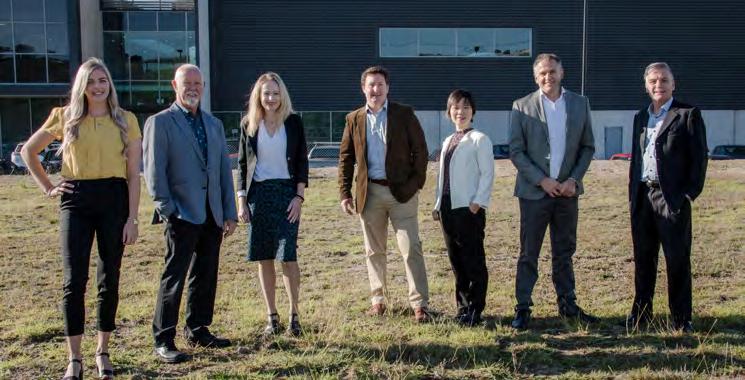
as it is a significant growth corridor for the Industrial and Commercial sector in NZ’s North Island.”
“With the size and breadth of our business across New Zealand our ability to bring genuine value through our significant Rural, Lifestyle and Residential Divisions to Philip’s team is what is seeing
Property Brokers exponentially grow up and down the country.”
Both Guy and Simon describe Property Brokers as, “Upfront, hard-working and true to their word, Property Brokers people are proud to live, work and play in the regions they serve. We give back as much as we can,” the
pair says. Under Philip Hunt’s ownership, Ray White Commercial Tauranga enjoyed a significant market share of Tauranga’s real estate for many years and was recognised as the Top International Branch for Customer Service for five years in a row. Hunt, who has fully supported the move, says, “Embarking
on this new journey with the same team of people I have been working alongside for so long is wonderful; we have long respected Property Brokers and are excited to start this next chapter.
“The size of Property Brokers’ infrastructure and associated networks is massive, and their marketing and network reach is something which I know our clientele will truly benefit from here in Tauranga.” Ray White Commercial Tauranga’s office and their Tauriko office will rebrand to Property Brokers effective 31st March 2022.
With a team of over 850 strong in more than 85 locations, the announcement of the acquisition with Ray White Commercial Tauranga further broadens Property Brokers’ commanding footprint and scale, adding even more resources and resulting in improved service for customers.
Scion recently released a report on how New Zealand might reach the objective of zero plastic waste.
“It’s doable, but difficult, and will require aligned efforts by science, industry, government and the public,” says Marc Gaugler report author and leader of Scion’s Distributed and Circular Manufacturing portfolio.
“Our research shows there is already extremely high commitment by industry, but they need support from central and local government in the form of clear and coordinated policy, regulation, incentives, and much better nationwide recycling systems. Consumers will have to do their bit. Without their demand and participation, it cannot succeed.
“We must also make sure that the strategy fits with other initiatives to reduce carbon emissions and pollution.”
The focus of the report is on re-using and recycling the plastics we mostly use now and stopping them from escaping into the environment. It comes as the Ministry for the Environment is seeking views on proposals to significantly transform recycling in Aotearoa New Zealand.
The report’s authors worked with industry partners to identify the challenges, barriers and opportunities to understand how global plastic supply chains are part of New Zealand’s transition to a new plastics economy.
Scion’s report follows the 2019 report on the New Zealand plastics problem by the Prime Minister’s
Chief Science Advisor, Professor Dame Juliet Gerrard, which lamented the lack of data on which to base a strategy.
She says, “It’s great to see this report aiming to fill some of the information gaps we identified in ‘Rethinking Plastics’ using a very practical, evidence-based approach.”
Earlier in March, the United Nations passed a landmark agreement to stop plastic pollution, and the New Zealand government announced a consultation process on separating household and commercial food waste, standardising recycling collection across the country, and a drink container return scheme.
“Plastic is an incredibly important material that, though carbon emission-intensive to produce, allows all sorts of efficiency gains,” Gaugler says.
“For example, plastics mean lighter planes and cars, requiring less fuel to run, and affordable, vital healthcare products. Recycling a metric tonne of plastic packaging into new products conserves almost 1.4 tonnes of CO2-equivalent emissions.
“Furthermore,” says Gaugler, “plastics are deeply embedded in so many industrial processes, we simply could not do without them. We have to turn the public away from the overly simplistic idea of elimination, and channel their goodwill into sensible reduction and re-use, consci-
Plastics are deeply embedded in so many industrial processes, we simply could not do without them. We have to turn the public away from the overly simplistic idea of elimination, and channel their goodwill into sensible reduction and re-use, conscientious recycling, and replacement where that is possible, without compromising food safety and protection.”

entious recycling, and replacement where that is possible, without compromising food safety and protection, for example.
“ There’s a lot of education that has to happen, but we have a New Zealand public willing to learn and keen to do the right thing.”
Scion’s work on New Zealand’s New Plastic Economy was funded by the Ministry for the Environment’s Waste Minimisation Fund. Scion is working on a number of projects to replace fossil fuel-based plastics, chemicals and other products with wood, bark and other plant materials.
The Scion report, titled Making zero the hero was launched at a webinar on Wednesday 23 March. A summary of the report is available on the Bay of Plenty Business News website and the full version of the report will be available on Scion’s website.
2degrees is once again Fighting for Fair for Kiwi Business, this time working with Microsoft and Umbrellar to deliver a streamlined ride to the cloud, with the launch of its new Cloud Navigator service.
The new relationship between the three organisations enables even better technology experiences for 2degrees customers, supporting the shift in the way Kiwi businesses are operating, adding another product to 2degrees’ already comprehensive business offering.
The Cloud Navigator portal, in partnership with Umbrellar, provides customers with self-service capability for managing and purchasing over 120,000 Microsoft licenses and products.
Cloud Navigator incorporates mobility, flexibility and insights says General Manager Business Product and Marketing Richard Hann.
“At 2degrees we pride ourselves on being a full-service provider of fixed and mobile communication networks, and now also provide access to these cloud services.
“We want cloud technology to be available for all Kiwi businesses from the beach, the park, or the home office. We are fighting for kiwi business’ freedom to deliver their customers the best of what they do, from wherever they want to do it.”
Users gain the ease of one account, the simplicity of one bill and the speed of one platform, plus 2degrees customer support, underpinned by Umbrellar’s cloud expertise. “This partnership with 2degrees signals a significant milestone in Umbrellar’s mission to empower all New Zealand businesses to achieve brilliant things,” says Umbrellar Head of Strategic Partnerships, Shavvah Aldred.
“NZ’s telco sector has ceaselessly remained at the forefront of digital transformation and technology sits at the core of its integrity and innovation.

“Umbrellar upholds its responsibility to promote transformation and uses its expertise to support the ongoing success of all New Zealanders. We are excited to be at the start of this journey with 2degrees, with Cloud Navigator destined to provide businesses with the tech they’ll need for tomorrow’s world.”
Matt Bostwick, Partner Director at Microsoft New Zealand says: “The cloud has increasingly become the place where business innovation happens, allowing more organisations to scale up and realise their potential with unprecedented access to new technologies.
“That’s why this partnership
between Microsoft, 2degrees and Umbrellar to accelerate cloud adoption, is so important to helping New Zealand level up its competitiveness and to helping Kiwi businesses get the access to the tech they need to succeed.”
Paul Bowkett, Channel Sales Manager at Microsoft New Zealand says: “This partnership will also enable local businesses to deliver more innovation that benefits all of us. We’re excited to work alongside 2degrees and Umbrellar to make that happen”. 2degrees developments underway this year aim to continue serving 2degrees business customers
in easy and simple ways, while delivering technology products and services to help them stay connected.
“2degrees Business is excited about what we have coming up in 2022, and what this relationship will achieve for our customers as we best utilise the expertise of each organisation,” says Richard.
For more on Cloud Navigator visit the 2degrees website.

on Thursday 14th April 2022.
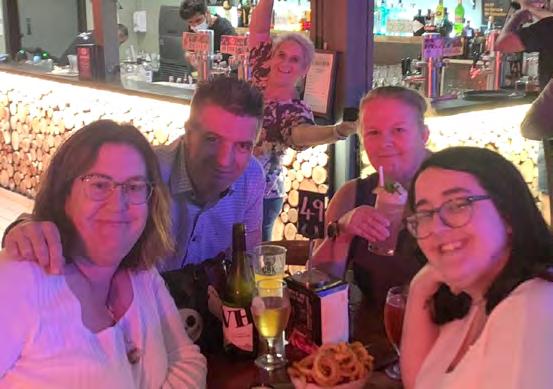

4 5 2 3

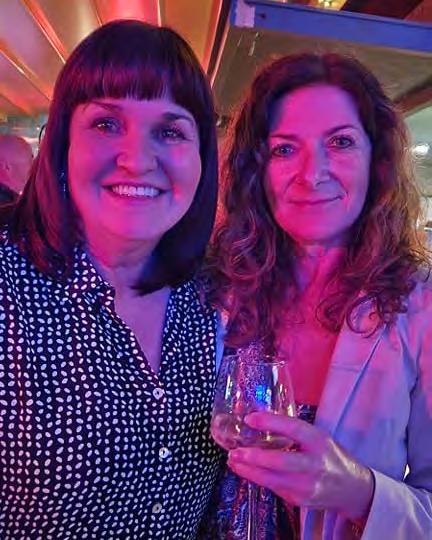

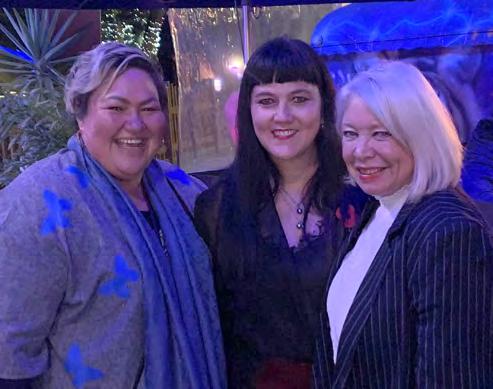
New research commissioned by The Warehouse reveals New Zealand is a nation of bargain hunters who love the feeling of finding a great deal now more than ever. Despite the cultural pressure of high-end labels, 96% of New Zealanders feel proud when they get a good deal on a quality product, and 93% believe they can get quality products at bargain prices.
The research also uncovered that almost 80% of Kiwis are now more budget-conscious due to Covid-19.
In a world where big spender culture is celebrated, bargain hunting was highlighted as the ‘new normal’ with more than half of respondents (51%) revealing they now actively search for bargains, wait for specials, and use discounts.
To reflect this cultural shift, The Warehouse’s iconic catchphrase ‘Where Everyone Gets a Bargain’ has been reinvented to showcase the smarts of small spenders. The new campaign ‘Hey, Small Spender’
celebrates savvy, smart Kiwis who love the feeling they get when they find stylish, quality products at low prices.
The research confirms that almost 60% of Kiwis feel like they’re spending smartly when purchasing comparable products without the big brand names, or waiting for discounts.
Sarah Kelsey, the 23-year-old Gen Z founder of financial literacy and personal growth podcast The OneUp Project, says the survey findings reflect the current cultural climate.
“I think people want to be able

to afford things before they go into debt, and financial freedom has become much more of a focus. They want to build sustainable habits for the future like spending small in a smart way.”
The research echoes Kelsey’s sentiment, with 3 out of 4 New
Zealanders (76%) saying they don’t believe they need to spend a lot of money on things to make them feel confident.
Jonathan Waecker, Chief Customer Officer at The Warehouse says, “With the cost of living increasing and the ongoing impacts
of Covid-19, there’s never been a better time to bring New Zealanders great value - now more than ever we need to celebrate feeling great about spending small and this coincides with a range of significant price drops that we’ll release in the coming weeks.”

New Zealand’s housing market has reached a clear turning point, as stretched affordability, higher mortgage rates and reduced credit availability cause growth rates to slow, or even turn negative, in many areas of the country.
CoreLogic NZ’s interactive Mapping the Market Report, which is updated quarterly and compiled using the country’s most comprehensive property data, has begun to show signs of weakness in dozens of suburbs.
Aotearoa’s property market proved highly resilient in 2021, maintaining feverish growth levels through Covid, snap lockdowns and border closures. But Mapping the Market’s latest release shows 154 suburbs have recorded falls in median values in the three months to February 2022, while 581 posted gains of 1.0% or more for the period.
CoreLogic NZ’s Chief Property Economist Kelvin Davidson said this quarter’s Mapping the Market had been adjusted to focus on the three-month value change (rather than the previous, slower-moving 12-month change), to give a more current and timely view of what’s been happening recently.
He said the altered comparison period neatly encapsulated the state of flux around market impacts from changes to loan to valuation ratios (1 November), credit contracts and consumer finance laws (1 December) and the spread of the Omicron variant.
“The figures are pretty revealing,” he said.
“At the headline level Mapping the Market shows an emerging weakness in parts of Auckland, Hamilton, Napier/Hastings, Wellington (especially Lower Hutt), Kapiti Coast, Dunedin and Queenstown. But conditions remain a bit stronger still in areas such as Tauranga, Christchurch, Rotorua, New Plymouth.
“Interestingly, although it’s early days yet, this is broadly in line with what we outlined in our vulnerability research last year, which emphasised the risks that can be evident in certain areas if affordability is too stretched, mortgage repayment problems are emerging, or investors start to sell, for example.”
The latest Mapping the Market report covers 960 suburbs across the country. Figures show of approximately 200 Auckland suburbs about 60 recorded a drop in median value of -2.0% or more in the three months to the end of February.
Prestigious areas of Auckland such as Remuera and Epsom have
“At the headline level Mapping the Market shows an emerging weakness in parts of Auckland, Hamilton, Napier/Hastings, Wellington (especially Lower Hutt), Kapiti Coast, Dunedin and Queenstown. But conditions remain a bit stronger still in areas such as Tauranga, Christchurch, Rotorua, New Plymouth.” – Kelvin Davidson
seen falls of -2.4% and -2.6%, equivalent in dollar terms to $68,100 and $66,200 respectively, and Queenstown’s Lake Hayes has also softened -1.9%, or $45,500.
Mr Davidson said a similar weakening had occurred in more expensive suburbs of Hamilton and Wellington too, albeit in those markets price falls are more spread across both upper and lower tiers of property.
“It’s important to note the news isn’t all downbeat, there are still nine suburbs where prices have increased at least 10% in the past three months and another 90 suburbs have increased between 5% and 10% for the same period,” he said.
“In fact, of the 960 suburbs covered, more than half (581) have still recorded price gains of at least 1% since November.”
Fordlands (Rotorua District) recorded the highest percentage growth in the quarter, up 15.4% to a median value of $457,850 followed closely by Leigh in Auckland, which increased 15.0% for the period to $1,473,850.
Mr Davidson said the quarterly results were best summed up as ‘mixed’ and provided a valuable indicator of the housing market’s current “plateauing” trend.
“The figures aren’t surprising and are exactly what you would expect to see as sentiment begins to turn,” he said.
“Our view is that a soft landing is still more likely than a major downturn, but the market will need to adjust to some economic uncertainty and higher mortgage rates.
“Buyers and sellers will naturally take some time to agree on where the new market normal lies, which will result in broadly flat housing prices at a national level – but falls in some areas offset by rises elsewhere.”

• Mapping the Market covers median values and three-month percentage and dollar value change of 960 New Zealand suburbs;
• 154 suburbs have recorded falls of -1% or more in the three months to February;
• 94 of the suburbs with >1% price falls are in Auckland, 19 in Dunedin, 14 in Lower Hutt, six in Hamilton, five in Kapiti and four in Porirua;
• The largest quarterly fall was recorded in Muriwai (Auckland) down -10.3% to a median value of $1,337,650;
• 581 suburbs recorded a quarterly median value
increase of at least 1%;
• The highest dollar gain in the quarter was Omaha (Auckland) up $253,000 (+9.4%);
• The highest percentage gain for the period was Fordlands (Rotorua District) of 15.4% ($61,000);
• Herne Bay retained its spot as New Zealand’s most expensive suburb with a median property value of $3,726,900 (up $109,850 or 3.0% in the three months to February); and
• Cobden (Grey District) is the country’s most affordable suburb with a median value of $231,900, up 1.4% or $3,100 in the quarter.
No surprise a million Kiwi workers need more digital skills
It’s not that surprising to see New Zealand needs to upskill a million Kiwi workers with better digital skills, as covid has accelerated the drive to digital for most businesses in New Zealand and around the world, NZTech chief executive Graeme Muller says.
Amazon Web Services (AWS) has launched a new research report which says the urgent need for Kiwi digital skills training became more acute during the pandemic.
NZTech’s digital skills for a digital future report released in 2020 highlighted the decreasing number of students learning digital skills in our education system and the growing need to have digital skills in many jobs.
It also pointed to the lack of focus on upskilling workers and the rapidly growing tech sector, all factors contributing to this massive needs for more focus on digital skills in New Zealand, Muller says.
“The AWS research shows while 97 percent of Kiwi businesses see a need to upskill staff with digital skills, only 25 percent are actually doing it.
“Like our research back in 2020, this report highlights similar issues such as limited awareness of what is available to help Kiwis gain digital skills and a lack of time.
“The New Zealand Qualifications Authority introduced micro-credentials to encourage shorter courses to support upskilling but a big issue continues to be a lack of awareness by Kiwi business and workers about what skills they might need.
“The government’s digital boost initiative, focused on encouraging small business owners to take up more digital solutions to make their businesses more productive, is an example of what might also be needed in the general digital skills area.
“Aotearoa’s digital industry transformation plan, currently out for consultation by the Ministry of Business, Innovation and Employment, has a large section dedicated to the critical need for improving New Zealand’s digital skills in order to ensure the digital sector continues to grow at pace creating thousands of new high paying jobs for Kiwis.
“There is no silver bullet to this global digital skills shortage, but if New Zealand can accelerate our local response we stand to gain considerable benefits including creating many higher value jobs, improved employee satisfaction and output, high productivity and high value exports.
“We need to pull every available lever to achieve this, marketing to encourage more people to want digital skills, creating new pathways and opportunities for training, leverage the (often free) training available from large multi-national tech firms to help our workforce upskill, and make it easier to attract and bring in the best possible digitally skilled talent from around the world.”
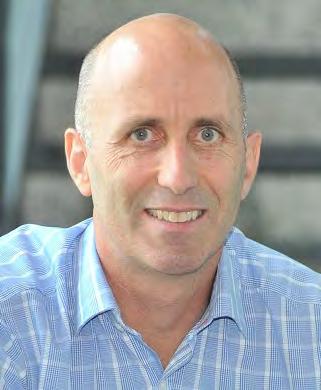
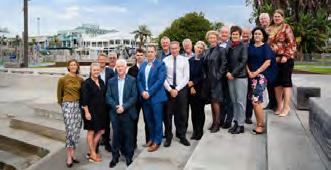





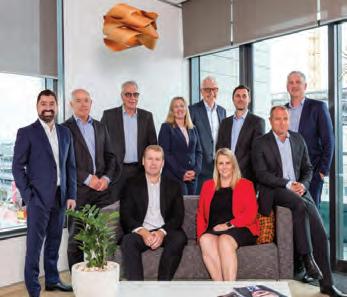

Call me old school, but there’s something authoritative and serious and necessary about the six o’clock news.
Yes, I know, I have had notifications and previews and breaking news alerts all day about the stories I am expecting to see on the six o’clock news. So why is it imperative that I sit down and watch it all over again on the TV news?
Ironically the six o’clock news is not ‘special’ news that I am paying a premium to subscribe to … this is good, old fashioned, free-to-air TV news (and yes, I also know that arguably I have actually paid a premium for it through my taxes, but let’s not get into that debate about state-funded media, cos that just goes round and round in circles).
I think it’s maybe the tradition, the pomp and ceremony that is ‘the news’.
In much the same way the Queens New Year speech always makes me feel calm, even if I don’t really listen to it attentively. The fact she’s making the broadcast at all means I can go about my New Year duties assured that life is secure for another annum.
Even strident republicans I know still watch coverage out the corners of their eyes
of royal weddings and have an opinion on Fergie’s dress sense or Andrew’s no-sweat condition – our lives without those voyeuristic royal stimuli would just seem American and shallow.
I read the newspaper, I listen to the radio, and I subscribe to The Economist – yet it’s not until I’ve seen the six o’clock news that I truly trust that the situations alarmingly foretold repeatedly during the day are really, truly as grave as I feared.
How dependable is the news?
The TV news for some reason seems to have gravitas. I’m not saying it is any more accurate, or any less biased than any other media source, simply that it feels more … dependable.
It’s not just the slick-looking, smooth-talking newsreader with his Gucci suit, or her edgy reo greeting (though I was always partial to a subtle eyebrow raise from Philip Sherry), or the glam studio set lighting, or the MGM “roaring lion style” intro music.


> BY ALAN NEBEN
Alan Neben is a Mount Maunganui local and experienced New Zealand Publisher. He believes that when the news is on, those who are not interested should, “get outside and play”. alan@bopbusinessnews.co.nz
It’s the tradition. Six o’clock is news time.
To sit or stand, hard to say –I’m a sitting newsreader kinda guy, personally.
And solo? Or paired with a co-presenter, preferably with a gender and race diversity nod included for good measure?
Call me boring, but I’m a go-it-alone newsreader advocate – real news should speak for itself and shouldn’t
need mildly humorous innuendo and guffaws exchanged between presenters. I want my news delivered as unadulterated news, no sugar added.
The first 15 minutes count
Not the whole of the news hour mind you – it’s only the first 15 minutes that really count; after that it’s TV click-bait, cross
promotion of their commercial offerings and human interest “local pensioner’s goldfish eaten by rabid mutant pony” stuff.
But the first 15 minutes, that’s the “sit up and listen” real news I’m talkin’ about. I’m happy to lose the other bits.
The weather, well it’s the weather isn’t it – a necessary part of virtually all regular
From last month weekend Rapid Antigen Tests (RATs) distribution in Opotiki was being led by three local rangatahi – Kanoa Rewiri (17), Trista Hudson (16) and Hoana Paruru (17). Supported by Te Ao Trust, KŌ Kollective Trust, and Opotiki Our Way, the three Opotiki rangatahi are part of a community effort to ensure local whānau have access to RATs during the weekend and are supported to isolate.
RATs are the main testing method being used to detect Covid-19 if you have symptoms or are a household contact. It is a self-administered nasal swab test, and a result is available in about 20 minutes.
Because RATs are part of the Covid-19 public health response, they are free for those that need them, and their distribution is being centrally managed.
People can request RATs online or by phone and then pick them up with minimal contact. Opotiki rangatahi are key to the local effort to ensure that RATs are available 7 days a week. “It’s been a great opportunity to give back to the community, help whānau and learn some new skills”, says Kanoa Rewiri.
With the Covid-19 surge, rangatahi stepped up to mahi aroha, or volunteer, providing additional support during the weekend.
As well as RATs distribution, the rangatahi are helping pack kai, delivering kai to whānau, and checking in with whānau who are isolating.
“It’s an extension of what I do at home. Sometimes I do the shopping and drop
off groceries. I am doing the same thing but just for other whānau,” says Hoana Paruru.
“I like being able to help keep whānau safe. It feels good to know that I am doing some positive to help others,” says Trista Hudson.
Local Opotiki voluntary and community organisations are looking to work with rangatahi to build on the mahi aroha work undertaken as part of Covid-19 recovery.
Overseas experiences show that Covid-19 is likely to remain in the community for a long time. New solutions and responses are needed as communities adapt and learn to live with Covid-19 as part of everyday life.
“These young wahine are an inspiration. They remind us that part of being a member of our Opotiki community is to extend our hearts and our time to help others in need when we can.
Engaging the good will of rangatahi and local whānau who wish to give their time and volunteer must be a key feature of our local Opotiki response as we recover from Covid-19,” says KŌ Kollective Trust Executive Chair, Shannon Hanrahan.

human verbal intercourse:
“I see Russia has attacked Ukraine, bloody terrible … and it looks like it’s gunna be raining here again tomorrow, bugger it.” Sport – that always comes included with the news deal; It’s like fries with a burger. The sport segment magically makes us feel active without even having to get out of our La-Z-Boy.
As I write this at 11.13am on a Friday morning (yes, I know, I’ve had all month and I’ve left it until the last day) and a notification has just flashed on my screen: “Russian President Vladimir Putin claims control of … more.” I think I’ll quickly turn on CNN now, otherwise it will be old news by 6pm tonight.
arwick Beban has been appointed managing director of Brother New Zealand, succeeding Graham Walshe who has held the role for over 40 years.
Warwick joined Brother as national sales manager in 2020, bringing a wealth of knowledge and expertise. He was previously general manager then CEO of Konica Minolta for 13 years, and prior to that spent five years heading up the Business and Corporate division at Telecom Mobile (now Spark).
Graham will continue to have an active role as a member of the executive and overseeing governance as chair of Brother New Zealand’s board.





*please visit our website for references to awards
